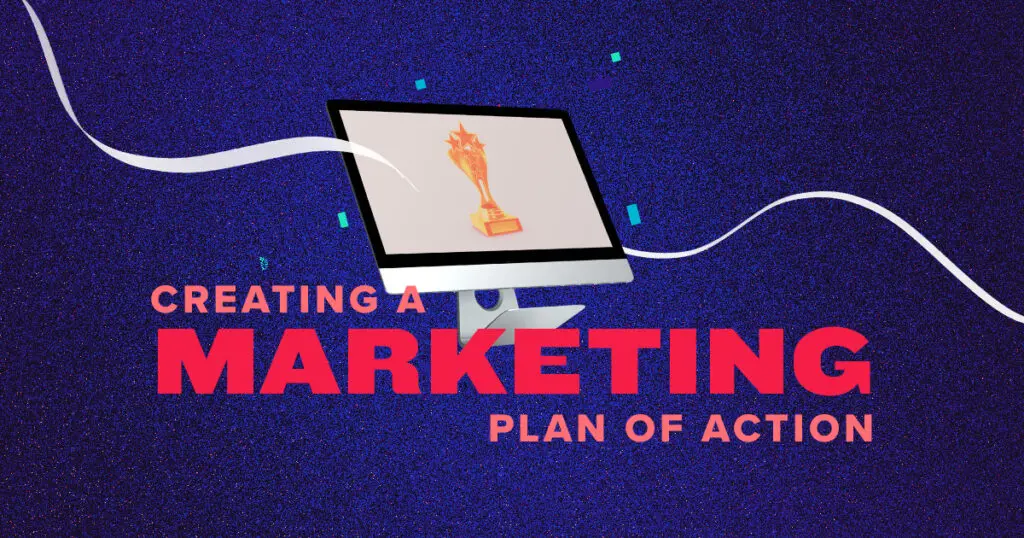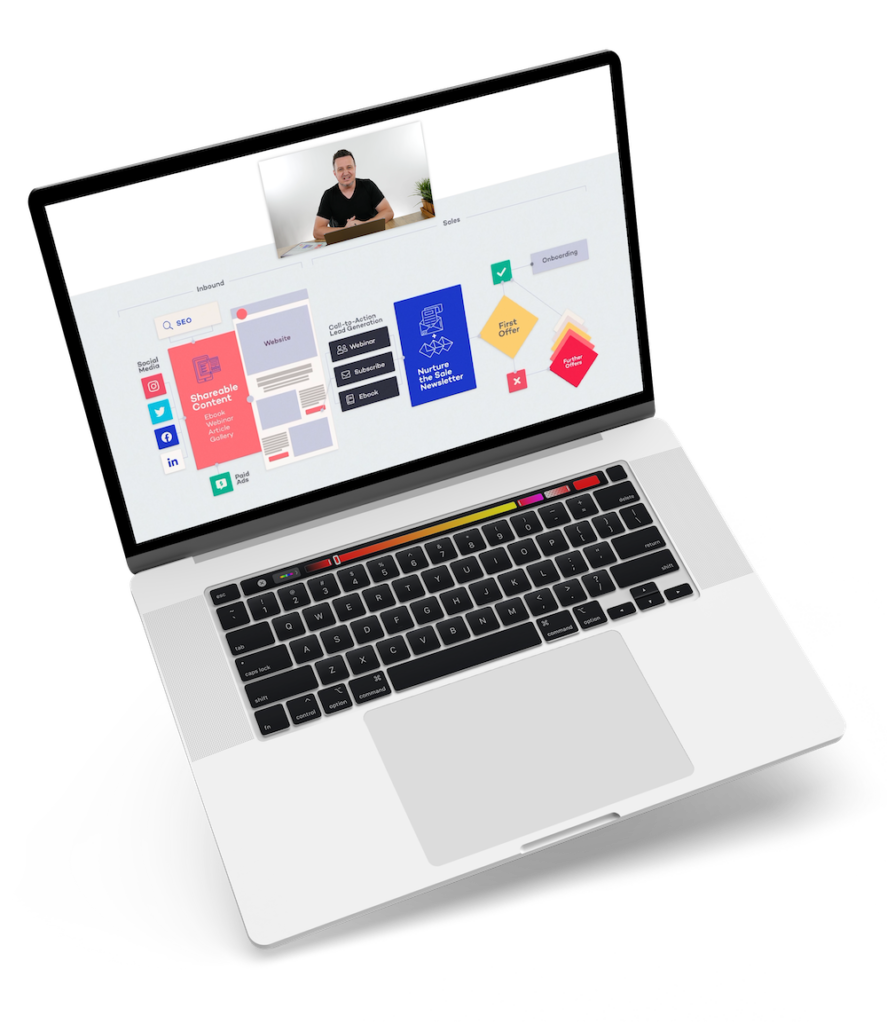When you think of marketing for your company, do you picture a list of tasks that need to get done or do you imagine a large-scale marketing plan of action?
It is essential to understand the difference between the two because marketing tasks will leave you spinning your wheels, working tirelessly without seeing many trackable results, while a marketing plan of action will give you a framework for organizing your tasks in a way that produces measurable results.
Simply put, marketing tasks equal marketing execution, and a marketing plan of action equals marketing strategy.
Without a marketing plan of action (marketing strategy), all you’re doing is running on the hamster wheel of marketing execution. To be fair, most businesses make this mistake. They think of marketing as having a list of weekly or monthly to-dos.
- Send the newsletter
- Post on social
- Run ads
- Update the website
There are no connections between each channel, and the strategy runs an inch deep.
Thus… they are on the hamster wheel of marketing execution.
Task. Done.
Task. Done.
Task. Done.
Task. Done.

To get off the hamster wheel of marketing tasks, you must first identify the building blocks of a successful marketing campaign, second, identify how each building block fits into the larger picture, and third, follow a step-by-step approach to create and execute your marketing strategy using the framework a marketing campaign provides.
In other words… you need to dig a little deeper than one inch.
Before you go any further, you need to be cautioned against three pitfalls that plague business owners or marketing managers, completely undermining the ability to elevate their marketing plan of action and, ultimately, their results.
These three pitfalls come directly from Jeff Walker, author of Launch: An Internet Millionaire’s Secret Formula To Sell Almost Anything Online, Build A Business You Love, And Live The Life Of Your Dreams.
In Jeff’s first instruction to the students in his Product Launch Formula course, he said three things will hold you back, and here they are:
- This isn’t going to work for me.
- I already knew that.
- I disagree.
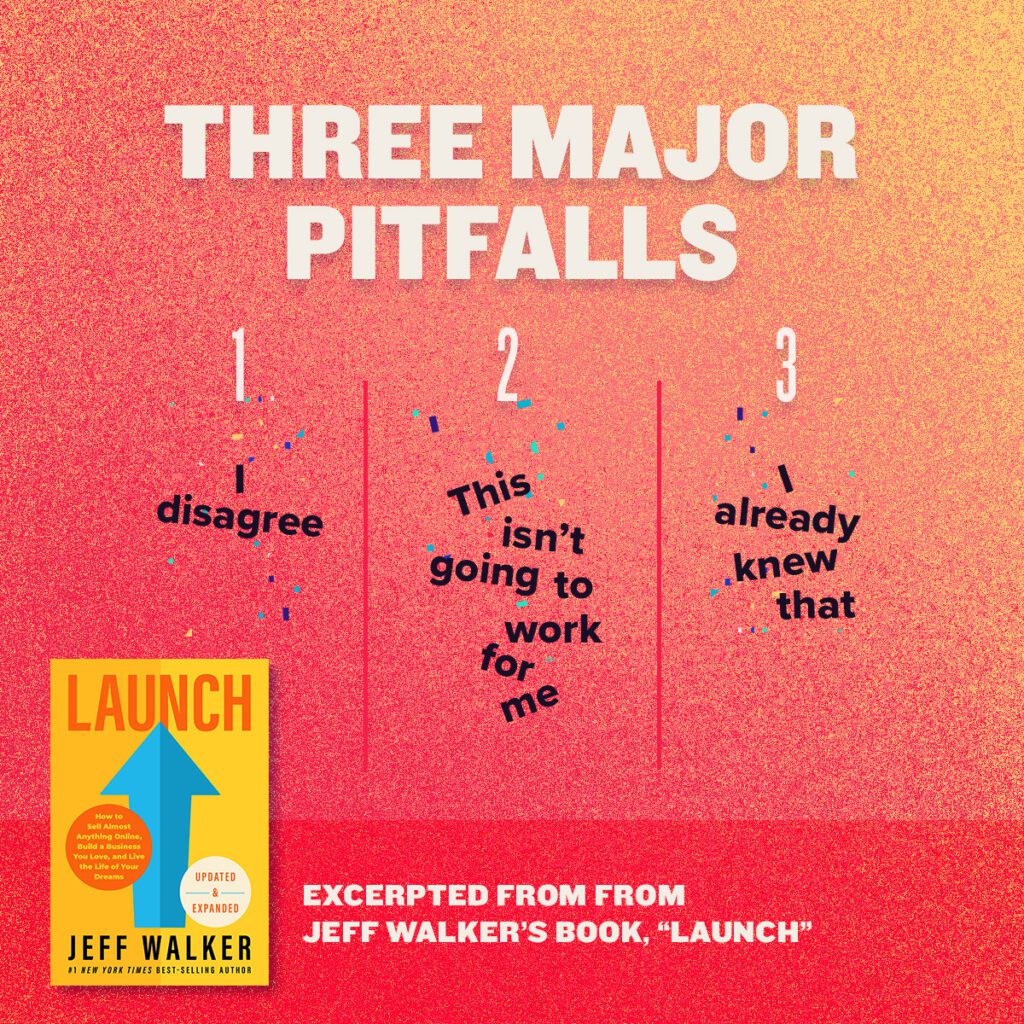

Part of the reason you are here is you’re looking for answers to make a successful pivot in your marketing plan of action; you need to eliminate mental barriers preventing you from embracing instruction and implementing changes to transform your results.
And they are, indeed, mental barriers.
There is a good chance you know about email marketing, social media engagement, and even paid ads. And maybe you’ve even had some success. But if you’re unwilling to step back and acknowledge, “Okay, there is something for me to learn here,” you will never experience the full potential of what you’re capable of while undermining your ability to be successful in the future repeating the steps you’re already familiar with.
Rather, it is preventing you from elevating your marketing acumen and benefitting from a larger marketing plan of action that brings all marketing systems together to work in harmony with one another.
We will cover the basics of online marketing as we go along, including choosing a theme for your campaign, building an irresistible offer, leveraging all your current marketing channels for maximum reach, building email marketing sequences, and more.
Plus, you will discover tips for identifying and tracking metrics to measure success. You can then use these metrics plus customer feedback to set yourself up for your future campaign success!
With this comprehensive, actionable how-to guide in your toolkit, you can create engaging marketing campaigns that deliver results (for your company and customers).
- Your team will have clarity on the direction and purpose of their work.
- Your employees will find their tasks more rewarding
- Your staff will discover a new source of motivation
- Your company will generate more revenue by meeting the needs of your customers with greater precision and clarity in messaging.
The question now isn’t “How do I create a marketing plan of action,” but rather, why would you not want a solid marketing plan of action?
Can you think of a reason? No? Okay, let’s get started!
Marketing Plan of Action vs Advertising vs Marketing Campaign
It’s essential to be sure we get our terms straight before going much further.
In this article, we are not spending much time on general advertising. While general advertising plays a role in a marketing plan of action, it is a long-term play, requires patience, needs ongoing financial resources to be effective, and is not as easily measured as a marketing campaign.
While general advertising can be a part of a larger marketing strategy when we say marketing plan of action in this article, we are focusing on creating a single marketing campaign or a series of individual marketing campaigns.
Furthermore, we are focusing our instruction and insights on digital marketing or e-commerce marketing specifically.
Some of what we share will be relevant to traditional brick-and-mortar businesses and certainly can offer some benefit, however, our intended audience is the business that primarily markets, interacts, and sells to its customers in a 100% online capacity.
Online stores, membership sites, subscription services, software, software as a service, broader e-commerce companies, and info course businesses will find the content in this article highly relevant and results oriented for their model of business.
What Is A Marketing Plan of Action?
Like many other aspects of business, there are a lot of interchangeable terms, and “marketing plan of action” is one of them. You could call it a marketing plan of action, a marketing plan, a marketing strategy, a marketing campaign strategy, or a marketing campaign plan.
As already mentioned in this article, when we say marketing plan of action we mean a marketing campaign.
You may think you know what a marketing campaign is — and in fact, you might be right. But are you certain? Would you be able to stand up in front of a crowded room of marketing professionals and with confidence and clarity describe exactly what a marketing plan of action is?
There is no reason to feel shame or embarrassment over what you have believed about marketing or that you may have potentially been wrong about what a marketing campaign is.
You’re here to learn, grow, and make a meaningful contribution to the world through your customers… and that should be applauded.
So, here is what you need to know about what an actual marketing campaign is.
A marketing plan of action is an organized effort to promote a product, service, or message through multiple marketing channels.
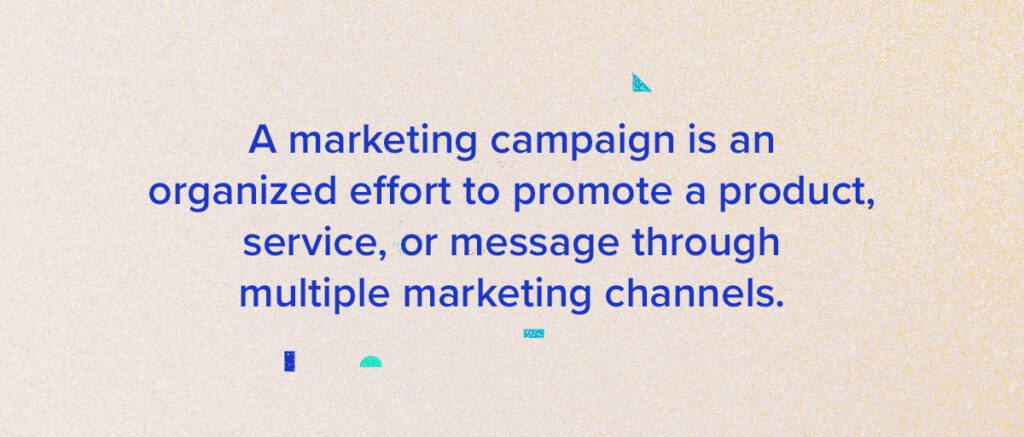

Yup, that’s it.
Said another way…
It is coordinating everything you do and say about your product or service for a specified period to generate a specific response from your audience.
Do not confuse advertisement with a marketing campaign. While a marketing campaign is focused on a specific message for a specific time to promote a specific product, general advertising is about raising brand awareness over a long time.
A great example of a marketing campaign is when McDonald’s brings back the McRib sandwich. Their marketing campaign is meant to get people into their restaurants to eat the McRib.
A superb example of general advertising is the commercials you see for healthcare providers like Banner Health. There isn’t a clear call to action or a specific time frame when action must be taken. Rather, the advertisement is meant to create awareness of the company, its values, and its core offer.
One of the biggest mistakes you can make in your marketing strategy is confusing advertising with a marketing campaign.
An effective marketing campaign requires you to identify the role each marketing channel will play, well-defined objectives, desired outcomes, identified audience, a specific theme, an angle for your messaging, and a singular call to action.
- Define your core campaign messaging or theme
- Define who your audience for the campaign will be
- Define how you will use your marketing channels
- Define exactly what action you want your audience to take
- Define a start and end date for your audience to take action
None of these are optional.
If you’ve tried to run a marketing campaign in the past and didn’t end up with the results you hoped for, there is a good chance you fell short on one or more of these non-negotiable elements. Accounting for all six does not guarantee success, but it guarantees that your campaign won’t fail for lack of a comprehensive strategy.
Creating a successful marketing campaign requires that not only each of these elements be accounted for but that each element be planned carefully, strategically, and given adequate resourcing to perform. What is adequate resourcing?
- Time
- Attention
- Energy
- Expertise
- Money
Time, attention, energy, expertise, and money are all required to push your marketing campaign forward and across the finish line. And that’s really what you want to do — cross the finish line. Not crossing the finish line means not receiving the reward promised at the end. While you may learn a lot in the process if you do not cross the finish line you will not achieve what it is you set out to do.
So what does crossing the finish line look like?
Keep reading, and you’ll soon discover much of what is required is simple, but it will all require — you guessed it — time, attention, energy, expertise, and money… and it’s vital you put all of these into practice in the correct way so you don’t waste any of them.
The Basics of Campaign Strategy You Need to Know
There are several basic starting points we need to cover in order to set yourself and your team up for a successful marketing campaign.
Your plan of action does not begin with sending messages to your email list or on social media.
To be honest, this is where many companies will go wrong. Without much thought or planning, a company will decide to run a sale or make an offer. Once that decision is made, a single email is sent or a social media post is made and then the entire team sits back and waits for results that are destined to never come.


It is not how it works and your past results can attest to this.
Still, it’s easy to forget our past shortcomings, believe this new offer (however short-sighted it may be) will make the difference, and then repeat past mistakes.
To avoid making the same mistakes of the past, we will go through a list of campaign basics to help you prepare for a different kind of marketing campaign in the future — a marketing campaign that crosses the finish line and gets results.
Start by Creating An Irresistible Offer for Your Marketing Campaign
You need an offer. More than that, you need a compelling offer. Nothing will derail your campaign and undermine your results more than a bad offer.
You need to get the offer right.
Offers from other companies are constantly coming your way. A value proposition in exchange for some form of currency, usually dollars.
When you walk into an electronics store or log on to an electronics store website, you’re immediately met with offers.
Seasonal sales
Limited-time discounts
Free gift cards
Complimentary gift
Bonus points
The more compelling the offer, the more likely you are to pay attention if not purchase.
In retail, most offers are financial by using sales and discounts. One reason retailers use financial offers so frequently is that they work. Another reason they make financial offers is that the markup on the products they sell is usually quite extensive. A third reason is they need to move the inventory out to make way for the latest models and newest technology.
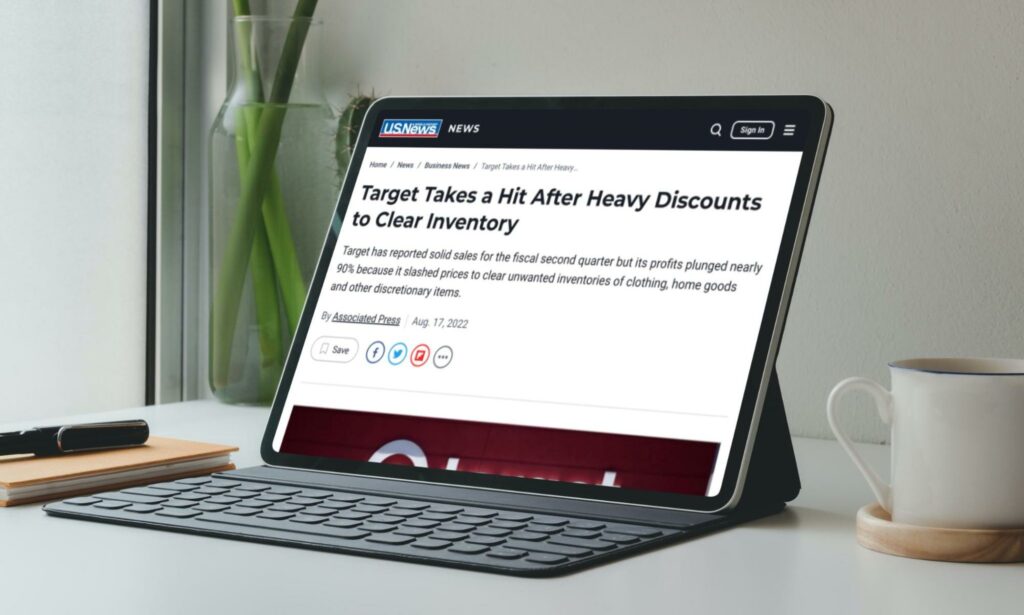

However, the financial offer is only one offer type you can use to encourage purchases as a part of your campaign.
There are three offer types:
- Financial offer
- Single-solution offer
- Support offer
You can use one or a combination of these offer types to create your unique offer that is irresistible and forces people to make a purchase decision.
To make your campaign a success you need an irresistible offer.
If you’d like step-by-step instructions for crafting your offer, sign up for our free introductory course below. When completed, you’ll be ready to craft an offer that anyone interested in what you do will have a hard time saying no to… in fact, it will be irresistible.
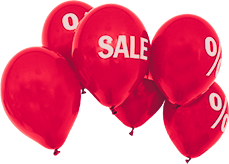

Create An Offer that Customers Can't Resist!
Free 7-part training show you how to form an offer with bonuses, addons, and savings without discounting your products.
For more insight into building your irresistible offer, you can listen to the entire podcast episode dedicated to the topic. Listen to the Irresistible Offer Episode of The Donut Shop Online Marketing Podcast.
A Quick Summary of The Financial Offer
As already mentioned the financial offer is the most common offer you’ll find in stores, online, and even on television (As Seen On TV).
Coupons, buy one get one, discount percentages, and limited-time sales: all of these are financial offers and they involve you discounting your products to entice a customer.
At The Blocks Agency, we do not advocate that our customers run financial offers that lead to discounting their products or services.
Why?
Because at the core, a financial offer is about giving a greater return for the number of dollars spent. So, instead of discounting a product, add value to the product. Instead of decreasing what the customer pays, increase what the customer receives.
You can do this with the other two offer types, however, you can alter the terms of a financial offer to make it work for both you and the customers.
For instance, if you are running a software company that charges by the month and you know that your average customer will stay with your company for 36 months, you can create a lifetime offer by inviting your customer to pay a one-time cost equal to 48 months. On average, you would lose that customer at the 36-month marker — so instead of waiting for the full 3 years to get the total amount, you give your customer something incredible in exchange for the amount up front… and receive 12 months of additional revenue that your averages say wouldn’t be possible otherwise.
This is one example of how you can get creative with financial offers.
While financial offers are perfectly okay to run, there is one reason you may want to reconsider running a financial offer… it ultimately devalues your product or service. If you normally charge $100 but are always discounting to $59, you are communicating the value of the product is really $59, not $100. If this is your business model, that’s fine. If it is not your business model, keep in mind every discount on your service decreases the perceived value of your service.
A Quick Summary of the Single-Solution Offer
One of the reasons the irresistible offer concept works so well is because often customers have already decided to purchase your product or service but the timing just hasn’t been right for them.
They have objections or reasons for why they haven’t completed the purchase, and the Single-solution Offer allows you to press the issue.
Customers will put off a purchase for a multitude of reasons, but they often sound similar to these:
- I don’t have time right now to get the full value out of the purchase.
- I will need this in about 12 months but don’t want to purchase it until then.
- I am working on x, y, and z before I can actually make use of the product.
- I can’t make the weekly meetings right now.
- I have prioritized several other purchases over this one.
- There is one element missing from your product causing hesitation.
People are unique, and that means their reasons for not buying will be unique — however, most of those reasons fall into similar categories and instead of taking ‘no’ for an answer, you create a solution for their problem that mitigates their reason for objecting.
For instance, “I don’t have time right now to get the full value out of the purchase,” is a legitimate and understandable objection. Instead of taking ‘no’ for an answer, you create a helper product called “Your Runway to Production” and this helper product gives a 3-month road map to prepare to use the product. You then include this helper product in your offer as a ‘bonus’ they won’t want to miss.
So while the person may not have time right now to use the product, they can begin setting themselves up for success when they have time. If they buy right away, they can begin making progress even if it isn’t with the full power of the core product. You have eliminated the core objection and given them a reason to purchase now.
Sign up for the Offer Intro Course and listen to the podcast episode for more insight into using the power of the Single-Solution Offer in your campaign strategy.
A Quick Summary of the Support-Based Offer
The support-based offer is exactly what it sounds like — there is an element of support and ongoing assistance between you and the customer.
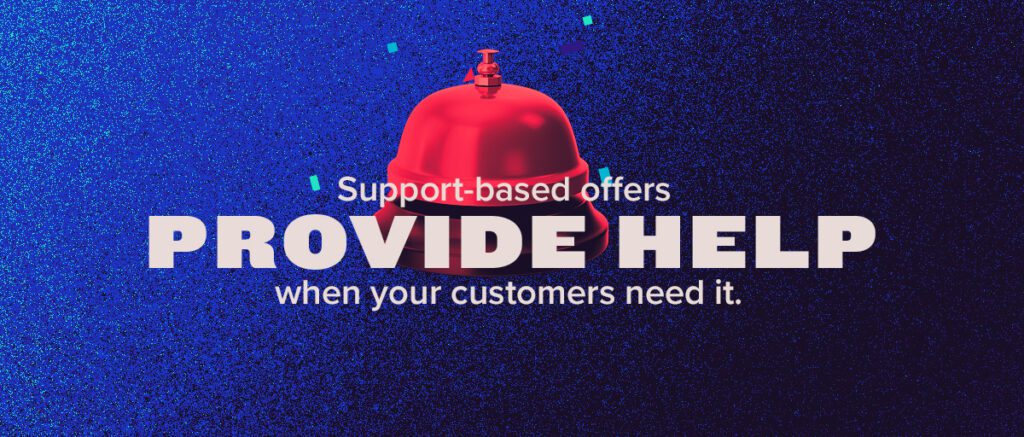

Support-based offers help customers feel more comfortable with their purchase because they trust they will have interactions to help them succeed. Many coaches and consultants use support-based offers in their marketing because it’s tied very closely to the nature of what they do.
However, this kind of offer isn’t just for those in coaching or consulting. Anyone can use a support-based promotion in their campaign to increase sales and drive revenue!
Kickoff calls, progress check-ins, weekly coaching calls, and support via email or messenger are a few ways to assure customers they will not be left high and dry. They won’t find themselves stuck, unable to move forward. While the way you fulfill your support commitment is important, it’s not as important as the customer knowing you are committed to their success.
One example of a support-based offer is promising an initial kickoff call and a final summary call. For customers who are concerned they won’t know how to get going, this eases their worry and even provides them with accountability on the back end with the promise of a closing call.
Another example of a support-based offer is giving access to a special communication channel, whether that be a messenger group, email ticket system, or something like the Voxer application. Whether the customer uses this support or not is irrelevant. The fact that it is offered is what makes your offer more compelling. The customer is paying for peace of mind knowing they will have help — not necessarily the help itself.
A few things to consider before you create a support-based offer:
- Only offer support you can fulfill with margin remaining. Do not overcommit to a nature of support that will remove you or your team from moving the business forward.
- Make sure support is time limited. It doesn’t mean you won’t help them beyond a certain point, it simply means the special support offer doesn’t exist indefinitely. Make clear when the support ends and what they can do for support afterward.
- Give clear instructions for how to obtain support and leave the ball in the customer’s court. While you may want to follow up individually with each customer after purchase and prompt them to take advantage of their support, don’t. Whatever you do for one customer, do for all customers. It is the only way to scale this sort of offer; in the same way that a gym knows not everyone will make good on their membership, not every customer will take advantage of the support… and that’s okay.
- Use systems, automation, and scheduling apps to manage support. Do not try to manage support manually or individually.
- The more your product costs, the higher quality clients you will gain, and the less hand-holding you’ll need to be responsible for. If you charge a very low amount, be prepared to provide a lot of support. If your price is higher, be prepared to give more specific support. It is the nature of support.
It is important to make boundaries clear and easy to understand so customers know what to expect. You can use scheduling links as one way of creating boundaries. These scheduling links can be made available for specific windows of time and can be turned on and off with ease.
Here are a few options for call-scheduling apps.
Another way to make boundaries clear is to have a comprehensive welcome email after the customer makes a purchase. This welcome email can contain all the details of their purchase and state very clearly what is included.
Simply being straightforward and honest with customers from the very beginning does most of the heavy lifting for you. It is easier to let out slack than it is to pull slack back in — so if you’re clear at the get-go, it will be easier to speak up when boundaries are being crossed.
Even with all of the cautions, support-based offers are strong and provide a pathway for another collection of buyers to move forward with their purchase, knowing they will be taken care of and you are invested in their success.
Branding Your Marketing Campaign with a Theme and Visuals
Once you have created your offer, you’re ready to brand your marketing campaign. Branding your marketing campaign goes beyond a logo or design. Branding your campaign is how you will visually and intellectually represent the value of your offer.
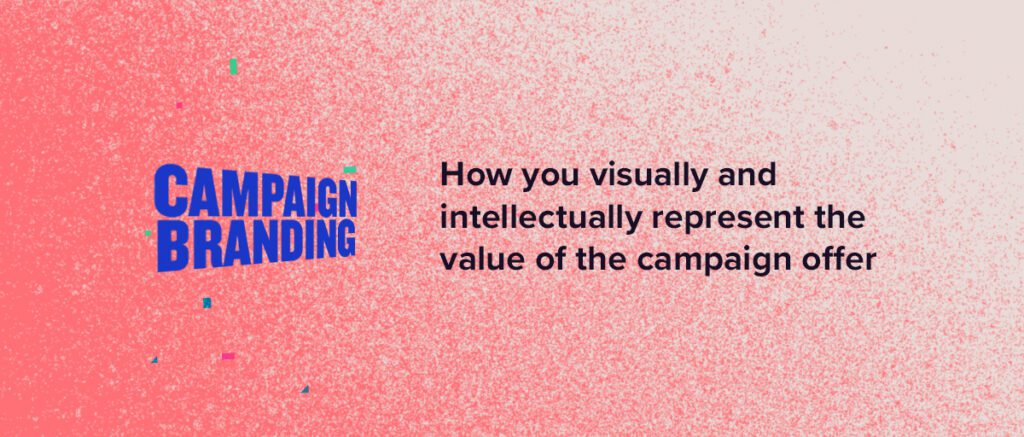

Yes, you could say 50% off or BOGO or 6 months of support included. But you’ve tried this sort of approach in the past. Slapping a banner on the product page saying “SALE” and then hoping it will be compelling enough to drive sales.
The key word there is hope.
Jeff Walker calls it “Hope Marketing” and it is not a good way to run a marketing plan of action.
You want certainty.
You want predictability.
You want consistency.
While branding your campaign isn’t a singular way to achieve these things — it is part of the equation for reaching the success you’re after.
The questions now are, “How do I brand my campaign? What does that look like? What do I need to have?”
While this could be an entire article all on its own, here is a summary of what you should expect to have on hand after you have properly branded your campaign.
Selecting A Campaign Theme
What feeling or emotion do you want to invite your audience to experience?
What value or benefit do you want to propose to your audience?
What your audience says about you when you’re not in the room is your brand but for an effective marketing campaign, to separate your product or service at this point in time, in this moment from all the other moments in time, you need something beyond branding.
You need a theme and the way you can think about your campaign theme would be to call it a rally cry.
Patrick Lencioni talks about the rally cry in terms of business and rallying the team around a single purpose. We want to steal this language, use it for the same purpose, and instead of leveraging the power of the rally cry for internal productivity, we will turn it around to put the audience focus on a single idea.
Our campaign.
Auto manufacturers are famous for this sort of theme.
December to Remember.
Truck Month.
Happy Honda Days.
Toyotathon.
Year-End Sales Event.
Volkswagen Sign Then Drive.
You don’t need to reinvent the wheel here (hahaha)… just copy what these other businesses are doing.
Instead of calling your promotion the “February Promotion” give it a name like the “Feeling Foxy In February” event. Instead of calling it your July sale, call it the Midsummer Classic Charge Up Promotion.
If you have an idea for a theme you can then wrap all your language and all of your visuals into that theme and bring everything together in a way that separates your offer for a specific moment in time.
Campaign Headline or Value Proposition (Text)
Having a strong headline or articulate value proposition does so much more for your campaign than serving as text on a page. It provides an excellent way to look at the big picture through the eyes of your clients. On top of that, it gives you direction for what to write.
This vital piece of branding will separate your campaign from a simple “BOGO” or on-the-nose sale sign. It creates a lens through which every email, ad, line of copy, and marketing material can be viewed.
In other words, it creates singularity in your campaign that will beckon people to a better way of life.
You may have one phrase you use privately that incorporates terminology that you wouldn’t want to share publicly. For instance, if your company has yet to make the quarterly goal and you want to help remind everyone of the importance of the event to meet the quarterly goal, you could incorporate that into the way you refer to the campaign internally.
The point is to create a lens your team can leverage into marketing content and the lens you instruct your buyers to see your campaign through.
It’s not “buy one get one.” It is “Success for today and success for tomorrow.”
Having a strong headline or articulate value proposition does so much more for your campaign than serving as text on a page. It provides an excellent way to look at the big picture through the eyes of your clients. On top of that, it gives you direction for what to write.
This vital piece of branding will separate your campaign from a simple “BOGO” or on-the-nose sale sign. It creates a lens through which every email, ad, line of copy, and marketing material can be viewed.
In other words, it creates singularity in your campaign that will beckon people to a better way of life.
You may have one phrase you use privately that incorporates terminology that you wouldn’t want to share publicly. For instance, if your company has yet to make the quarterly goal and you want to help remind everyone of the importance of the event to meet the quarterly goal, you could incorporate that into the way you refer to the campaign internally.
The point is to create a lens your team can leverage into marketing content and the lens you instruct your buyers to see your campaign through.
It’s not “buy one get one.” It is “Success for today and success for tomorrow.”
Signature Campaign Image
Your visual branding is essential. Not because visual branding alone will carry your campaign. We’ve all played that game of investing hundreds or thousands of dollars into logos thinking, “If I just have a good logo people will buy.” That never turns out to be true.


But if your product is strong, your testimonials are plentiful, your audience is well defined, your messaging is clear and concise, and your buyer experience is streamlined, then yes, a strong visual to capture the promise of your campaign offer will bring everything together to project a higher perceived value over your normal offer as well as your competition.
In other words, don’t overestimate the power of your campaign artwork, but don’t underestimate it either.
At The Blocks Agency, we create a signature campaign image for every campaign. Why do we call it a signature image? It is the singular image concept upon which all derivative images will be based.
We will design the signature campaign image at either 1920 x 1080 or 1200 x 630. The size isn’t important. What is important is that the image is strong and has enough definition to inform or inspire complimentary designs, including sales page style.
Here is a list of standard designs you can expect to need when executing a campaign plan of action.
Signature Image — The primary design which serves as the campaign brand. All other designs will be based on this look.
Group Product Mockup — A visual depiction of your product or service.
- This could be a computer mockup with your SaaS or membership website on the screen
- It could be a box mockup to depict downloadable resources
- Mockup of papers or notebooks for templates
- T-shirt mockups for shirts, book mockups for books, and iPad or tablet mockups for ebooks
- Providing some kind of visual representation of your product or service makes the results feel more tangible
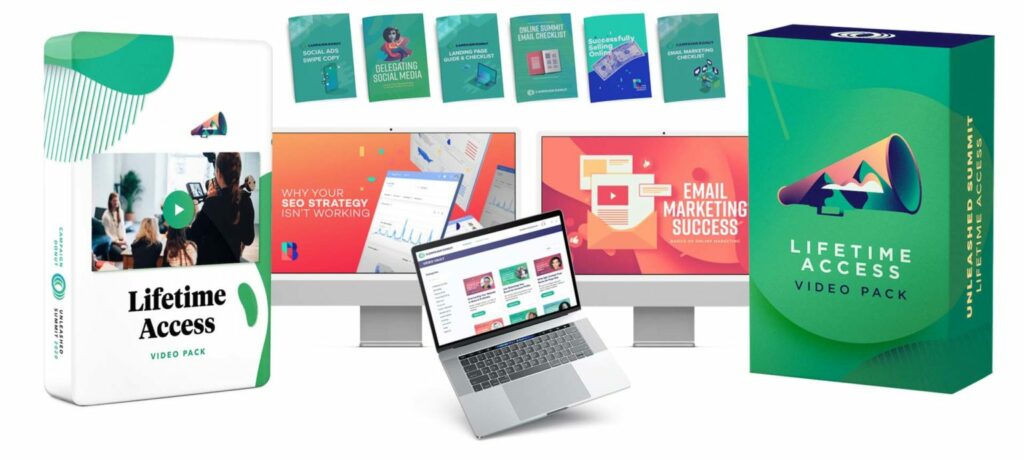

Individual Product Mockup — Not only do you want the product mockup of your entire offer, but you want individual mockups of each product in your offer. Consider you have an offer that includes six items. If you showcase them as a group product PLUS separate each item from the group into individual images, you now have SIX different products to talk about instead of one singular offer.
Let’s say your membership service offer includes 10 worksheets. Include those worksheets in the group mockup, but then separate them as a ‘bundle of worksheets’ and talk about them separately.
The more items you can showcase on your sales page, the more you have to talk about. The more you have to talk about, the greater the perceived value of the offer.
Social Sharing Thumbnail Image — It is entirely possible to have more than one social sharing image for your campaign. You may want a social sharing image for your campaign theme and a second social sharing image for your sales page featuring a product mockup. It could be that you’re running a webinar and you want a social sharing image for the webinar unique from your campaign and sales page.
Bottom line, what do you want to appear when someone shares the link via text, on social media, or when an app shows the associated thumbnail? This is your opportunity to influence the way your campaign elements are perceived and received.
Social Media Support Images — It’s a good idea to have a variety of graphics to share on social media over time so as to not wear out the impact of your main image. For instance, if you’re going to share one image every day for the run of your campaign, if that image appears every day on your feed, by day three users will begin to tune out. Having several images to rotate through will build momentum over time.
Video Support Images — If you are running a webinar or online event (more about these below), here is a list of the graphics you’ll need (which can be designed to match your theme):
- Main slide, 1920 x 1080
- Presentation slides (backgrounds and layouts)
- Lower third slides (names, links, etc.)
- Offer slide (with your product mockup image and pricing information)
- Sticker overlays (icons, product mockups, etc.)
Beyond a launch event, have a collection of designs to use in conjunction with any videos you may run on social media or otherwise. Having graphics consistent with your overall branding theme will bring further brand authority and offer awareness.
Paid Ads Graphics — If you’re running paid ads (social, search, or ad network) you’re going to need a wide range of graphic dimensions.
- Square
- Widescreen — 16:9 ratio
- Vertical video — 9:16 ratio (holding your phone to record vertically is called vertical video)
- Social sharing size will cover your basic social platforms
For an ad network you’re going to have the option to use
- Large rectangle
- Medium rectangle
- Billboard
- Skyscraper
- and more
Having a strong signature image will help you create these various image sizes and applications — not only will it help you create continuity between each element, but it will also speed up the amount of time it takes to create each design.
Essentially, you have a visual framework to follow.
There are so many additional applications for which you’ll find graphic design needs, it would be impossible to list them all. However, the placements mentioned above are fairly standard and will give you and your marketing team a place to start with clear expectations. From there you can discuss what additional applications are needed and how to modify your designs to suit those individual needs.
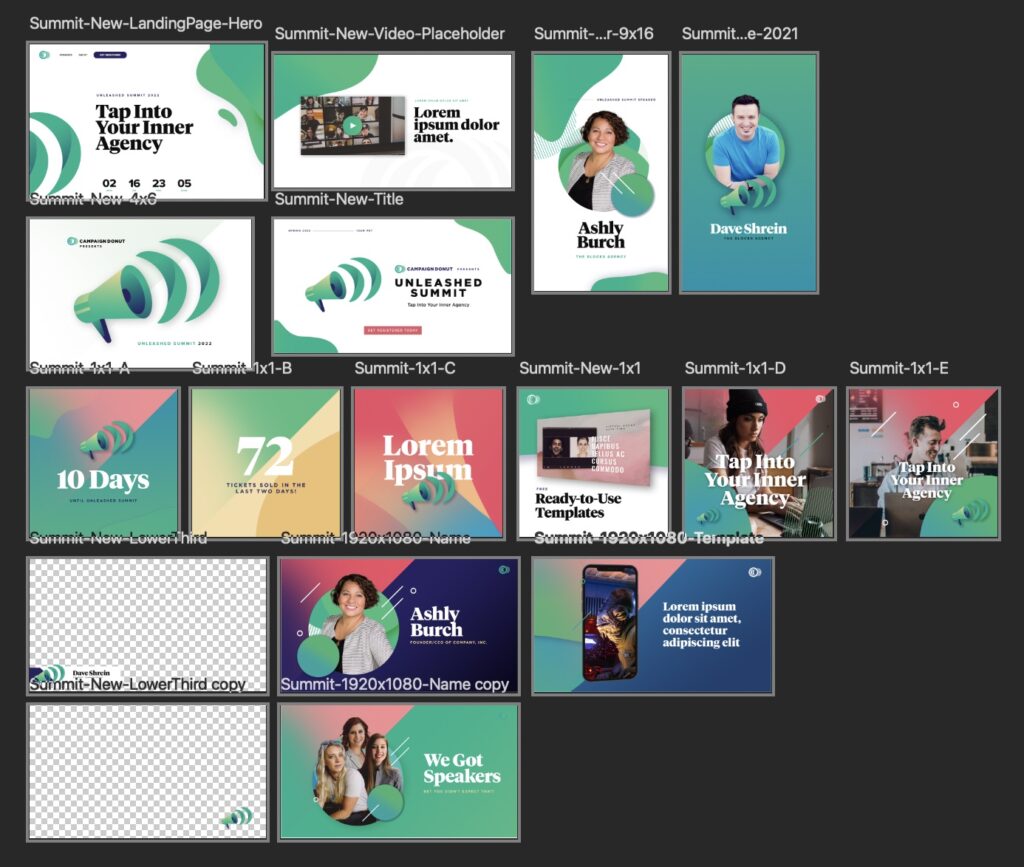

One final word of instruction…
Have all of your visuals designed and available for use before you reach day one of your campaign. This is a completely reasonable and achievable task.
Putting off anything (graphic design or otherwise) to the days after your campaign begins is, quite frankly, stupid.
You want your time to be free to respond to immediate needs during the run of your campaign, and having all of your designs complete will help you keep a good rhythm in servicing your campaign and give you margin for responding to immediate and timely needs in the campaign timeline.
A Strong Marketing Team to Pull It All Together
Having your offer, your theme, and your brand defined is great! These are the first three basics you will want to have in place before you begin to execute your marketing plan of action.
But you need a marketing team to help you pull it all together. Yet, you’re hesitant… You are well aware of the risks that come with delegating your content creation to others…
In fact, your hesitancy to delegate may be because in the past your people fell short of your expectations.
While this article is not about team building or training, it is important for us to mention several truths.
Important Truths for Running Your Marketing Team
First, no matter how talented, gifted, or skilled someone is, without a clear direction to apply their abilities, they will almost certainly fall short. Your past efforts were plagued because they were rushed, generic, and shallow. It means the people who were responsible for results were not given the correct coaching or vision to produce content that felt definitive, unique, and compelling. This time you’re doing it differently so you should expect more from your team.
Second, if you do not trust someone on your team to perform their job you need to make a decision. Did you hire the right person for the job? Are you asking someone to do something that is outside their expertise? Is the person going to perform better with a clear vision? Only you can make these decisions and you must, in fact, make a decision. If you can’t trust people to do their jobs, you either need to change your expectations, change the job description, or change your staff.
For more insight into this second truth, read Jim Collins’ book, Good to Great: Why Some Companies Make the Leap… And Others Don’t.
Third, you need to communicate what level of autonomy your team members have when performing their tasks. You don’t want to be a micromanager. Yet you also aren’t confident you should just let go and let them get to work. This will almost certainly end in disappointment. Provide very clear and explicit instructions for what they are to do and how much freedom they have to experiment. Do not confuse micromanagement with providing clear directions.
Finally, make sure you are clear about your expectations for each person individually and for the campaign as a whole. A good coach lets the team know exactly what the expectation for the season is.
✅ Making the playoffs.
✅ Achieving a particular record.
✅ Getting to the state championship game.
✅ Winning state.
Tell your team exactly what your expectations are and hold them accountable for those results. Give plenty of room and space for them to ask for help, ask for clarity, and voice concerns so they feel supported and know they can come to you to work through issues that may arise.
Managing Your Marketing Team and Campaign Results
It is impossible for you to do everything on your own. Absolutely impossible. As a matter of fact, not only do you not have enough time in the day to be the only person executing your marketing plan of action, you do not possess the necessary skills to pull it off.
This doesn’t mean that if you’re a solopreneur right now you can’t create a marketing campaign. You most certainly can pull this off. You will just need to prioritize where you put your time and energy.
For instance, if you’re not a graphic designer but you are a strong copywriter, do not focus on the graphics or branding. Yes, these are important, but your time will be better spent writing killer copy for your ads, emails, and sales page. If you can hire a graphic designer, great. If you can’t, find a solid template look on Canva or another similar tool that will do the job and create it as quickly as possible.
Below, we will look at the different roles, responsibilities, and tasks you’ll need to execute your marketing campaign. The better you do at matching each one with a team member who is skilled in that particular area, the stronger you can expect your results to be.
To keep everything organized, it is important to have some sort of centralized system for project management. You can use Monday.com, Asana, ClickUp, Trello, Wrike, or even Google Sheets. The system you use is less important than actually having a system and devising an effective way to use that system. Itemize every task and assign each one to the appropriate person. Don’t get too focused on the level of detail. For instance, if you’re assigning “Facebook Ad Copy” don’t worry about itemizing:
- “Write headlines”
- “Write descriptions”
- “Write main message”
- “Choose CTA button”
That’s a lot to manage and keep track of. If you do want to get detailed in your instruction, create a tutorial or link to someone else’s tutorial in the main task and even provide examples of what you’re looking for. This is what we do at The Blocks Agency. We have run hundreds of campaigns, and when we run our next campaign, we’ll include the same tutorials in the task along with our best examples from past work.
Bottom line: don’t try and do everything yourself. Make your expectations as clear as possible for the people you delegate to.
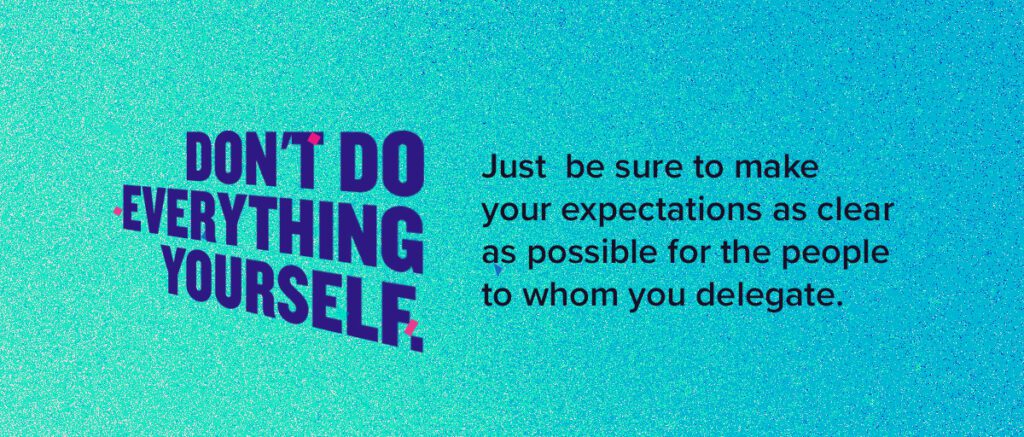

Marketing Channels and Applications
As simple as a marketing campaign can be in concept, there are a lot of moving parts. Being aware of these moving parts, how they work together, how to leverage each one to your greatest advantage, and how to service each moving part is what will enable you to cross the finish line.
And make no mistake, moving your marketing campaign across the finish line should be your number one goal. Campaigns that convert cross the finish line… the number one reason campaigns don’t convert is because they fail to cross the finish line. It is that simple.
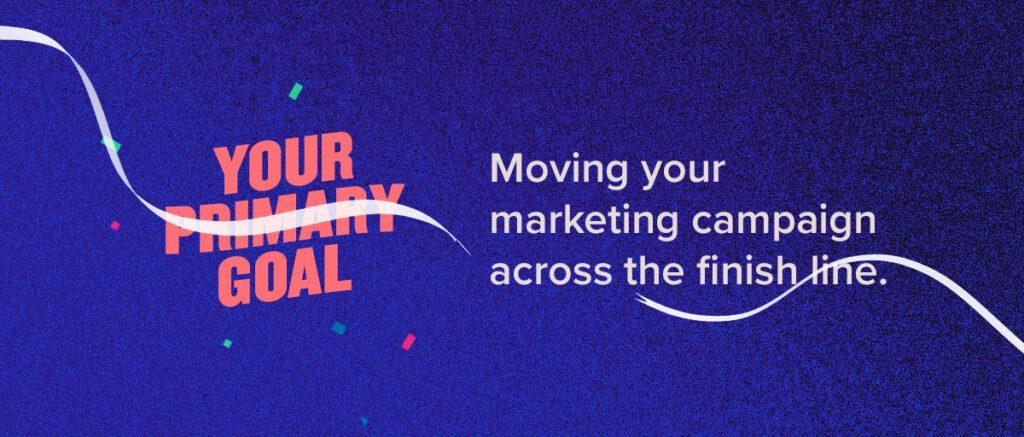

Right off the bat, you want to take inventory of your current marketing channels. This can be social media, website, email lists, ad accounts, or printed materials — anywhere you promote and publish content related to your business can be considered a marketing channel.
We’ll go through a list of channels all businesses will have access to, though you may not use all of them and there may be some you use that we don’t cover. That’s not important. What is important is that you get a vision of how each channel will play a role in your campaign and proceed to fully support the communication of your campaign messaging on that channel.
Website Marketing Sales Pages, Banners, and Notifications
Your website will be the home base of your marketing campaign.
How this plays out can vary from company to company, but here is a breakdown of what you’ll need to consider creating on your website to get the most out of your efforts.
- Sales page
- Campaign ribbon
- Announcement popups
- Social proof notifications
- Redirect page (after your campaign)
- Supporting content
Later on in this article we’ll go through each of these individual items in greater detail to provide a more comprehensive understanding of what each is and how each one plays a unique role.
Email Marketing During Your Campaign
You need an email list. This is probably not the first time you’ve heard this. Maybe you even took the advice and built a solid email list of several hundred or several thousand users.
The reason you want a list is so you have an immediate audience for your campaign! It is the entire point.
Your audience for your campaign is not the people:
- Who happen to arrive on your website
- Follow you on social media
- Click through your paid ads.
These people are valuable and they matter, but they are not the target of your campaign.
The target of your campaign is your email list. The people you have control over contacting. You can’t determine whether or not they open your email, but you can decide when to place an email in their inbox. It is why having an email list matters.
If your list is small, that doesn’t mean you can’t run an effective campaign — it just means you’ll have fewer ‘at bats’ to make a sale. But that’s okay… because this is not the last time you’re going to run a marketing campaign.
Right? 😉
What do you need to say in your emails? How many should you send? Keep reading and we’ll get to those answers.
Marketing Campaign Paid Ads
Search ads, social ads, or ad networks. No matter which network/s you decide to use, there are two sets of ads you’ll want to consider running and a bonus third set.
Your first set of paid ads will be pre-campaign ads.
Pre-campaign ads will foreshadow your upcoming campaign. How vivid or abstract that foreshadowing is will be up to you. But the idea is to begin a conversation, start garnering eyeballs/interest, and get people curious about what you’re doing.
Your second set of paid ads will be promoting the campaign itself.
If you’re running a sale, these ads are explicitly about your sale. If you’re opening your cart for a limited time, these ads will be time sensitive and make the stakes clear. However you angle these ads, the goal is to make the offer obvious and compelling.
The third and ‘bonus’ set of ads is general awareness advertising ads you can begin running immediately.
Yes, we said we wouldn’t talk much about general advertising, but one of the great benefits of digital ads is how easy they are to create, how cheap they are to run, and how quickly you can get measurable results from them. It makes paid ads ideal for a marketing campaign and general advertising.
Your paid ads strategy needs to be focused on targeting people in your ecosystem, people who are familiar with your brand, and people who have indicated interest. This is where it becomes important to market SPECIFICALLY to people on your lists or who regularly visit your website. Do not market your campaign to cold traffic.
Social Media Campaign Posts
Some businesses thrive on social media all year long. Influencers, content creators, and celebrities work hard at publishing content that is consistent in schedule, quality, and content type. Your business may not have the same viral following as these social media users and that’s okay. Still, your social media accounts will play a role in your marketing campaign.
For the duration of your campaign (including the pre-campaign period) you’ll use social media in three ways.
- Whet the appetite of your audience for what’s coming up. Don’t wait until your campaign is in full swing to share several posts on social media. Publish several posts in the lead-up to your campaign start date. Even if these posts are mysterious and hint at something coming, that will be enough.
- Publish regularly throughout the duration of your campaign, and don’t wait till the last minute to draft each post. Think well ahead of time about what will be compelling, eye-catching, and irresistible enough for users to 1) stop the scroll and 2) take action to explore your offer.
- Have a regular and active social media presence on the social media platforms where you will run paid ads, regardless of your campaign initiatives. When you run paid ads, users who are unfamiliar with your brand but intrigued by your ads will click on your profile to verify if you exist. If they show up on your page and it’s a ghost town, don’t be surprised if they believe you are not a real company or you’re not going to be easy to get a hold of when they need help. Posting regularly, regardless of engagement, will bring a certain level of credibility to your ads because it will show you’re real, active, and available.
For most companies, the promise of organic social media attention is overrated. The investment in organic social media is very similar to an investment in the Better Business Bureau: it won’t mean much to those who aren’t looking for it, but when someone investigates your company, having it will elevate your credibility.
Campaign Webinar or Launch Event
How would you like your company name implanted in thousands of personal calendars?
Think about it, thousands of people who match your customer persona, saving a date to give you their time and attention.
This is what you get with a webinar or a launch event.
Not all campaigns warrant a large-scale event, but the ones that do warrant such a spectacle only benefit from it.
A webinar or launch event serves as a powerful and singular call to action for your campaign.
Think about big sporting events such as the Super Bowl, World Series, or even the Olympics. There is a date for the event to begin and in the weeks and months preceding the event, advertisements begin ramping up.
Let’s focus on the Super Bowl.
- Announcement of where the Super Bowl will be held (usually 2-3 years in advance).
- Fans, media, and business reps book hotel and travel reservations.
- Vegas has odds on Super Bowl teams and the eventual champion.
- Sponsors are announced throughout the length of the season.
- The Super Bowl Halftime Show performer is announced.
- Local businesses begin advertising their events and happenings during Super Bowl week.
- NFL starts to promote NFL Experience and other festivities with ticket sales.
- During weeks 17 and 18, the commentary is all about playoffs and the road to the Super Bowl.
- Playoffs begin and ads for the Super Bowl begin to run with date and time information.
- National advertisers start leaking information about their Super Bowl ads.
- Throughout the playoffs, the narrative is “Road to the Super Bowl”.
- The two conference championship games take place, and the winners go to the Super Bowl.
- In the last two weeks leading up to the Super Bowl, week 1 is media week.
- People begin traveling to the Super Bowl city.
- The week before the Super Bowl is filled with festivities, parties, and individual events.
- TV stations, sports networks, radio stations, and podcasts are all talking about the game on Sunday.
The metric the NFL and broadcasting network is looking for is viewers for the Super Bowl. The tickets will sell out. The NFL experience and other parties or events are important and will sell out.
But the thing the NFL gets big bucks for is the rights to broadcast the game… and in order to recoup the money they pay out, the network wants as many viewers as possible so they can charge as much as possible for advertisements.
Everything points to the Super Bowl and all of the build-up is meant for one thing — show up to watch the Super Bowl on the second Sunday in February.
Follow the NFL’s blueprint. Albeit, yours most likely won’t be on a global scale, the principle of what the NFL does is simple enough to see how it could apply to your business, to your products.
A personal calendar is one of the, if not the most intimate place your company name can appear, and hosting a webinar or launch event for your marketing campaign gives you access to that exclusive location.
The Role of Search Engine Optimization In Your Marketing Campaign
Search Engine Optimization, SEO for short, will not play a role in your actual marketing campaign. Because it can take up to 6 months for content to make headway in ranking, you can’t count on SEO to fulfill any meaningful responsibilities during the blitz of a campaign.
This doesn’t mean you can ignore it.
SEO plays an important role in your overall marketing strategy and because of this, the value is far more wide-ranging to all of your campaigns over the life of your company rather than providing value to a single campaign.
One way SEO could play a part in a single campaign would be if you know what your campaign theme will be 12 months in advance and want to produce a pillar page of content that relates to your upcoming campaign. If there is enough opportunity in keywords (low competition, high volume) you could produce a strong pillar page a year out, use the first six months to begin to rank and if the piece is successful, the following six months could produce strong traffic.
While it is not a certainty the article will rank and bring in new eyeballs, if it’s valuable to your company beyond a single campaign, it could be worth looking into.
Marketing Campaign Website Strategy
The backbone of your campaign will be your website. All emails, ads, social, and CTAs will point back to your website.
But not just any page on your website. You need a sales page.
In the same way your website provides a home base for your company to communicate to the world, you need a single landing page — a sales page — as a home base for your campaign to communicate with your audience.
But the work you have to do on your website goes far beyond a single page. Here is a quick breakdown of how you can put your website to work to do a lot of the heavy lifting during your campaign launch.
- Sales page
- Campaign ribbon
- Announcement popups
- Social proof notifications
- Redirect page (after your campaign)
- Supporting content
And with that list, we’ll go ahead and look at what you need to consider for each of these items.
Marketing Campaign Sales Page
Sales Page Dedicated to Your Campaign
Create a specific sales page on your website that is clearly tied to your campaign. This means whatever artwork you use in your ads, social media, videos, signage, or other applications, you want to use this artwork on this specific sales page. Make it clear that this sales page is unique. It is not a normal page that is always available. It is tied to something specific and something special.
Top or Bottom of Page Ribbons, Sales Bar, or Sticky Bar
Ribbons can go by all sorts of different names. When we talk about a ‘ribbon’ we’re talking about a notification at the top of your website that appears by pushing your main content down and diverting attention from the web page to the bar. It then redirects the user to your sales page.
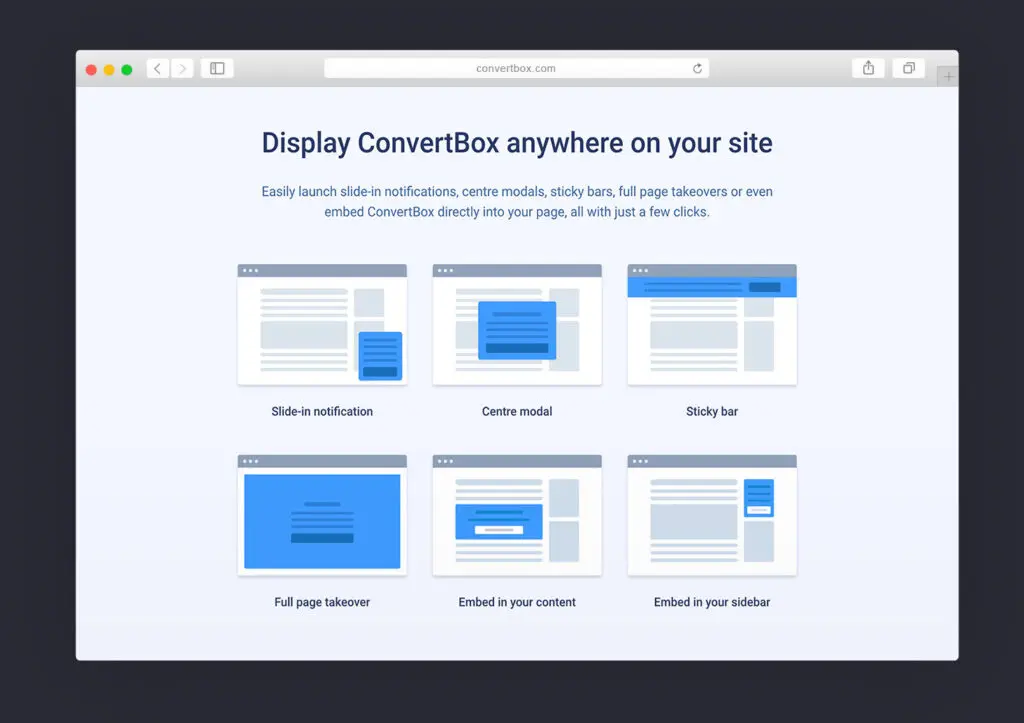

For instance, maybe you’re running a Black Friday promotion and you’re not mentioning it on your home page. Have a top-of-page ribbon that pops up when a visitor arrives, offers a button to click, and then redirects the user to the Black Friday Sales Page.
This is an incredibly effective way of putting your campaign front and center without altering the core pages of your website.
BONUS STRATEGY: If you own multiple websites that are related, it is worth considering using these top ribbons to point to your campaign. If the sites aren’t related or you don’t want to sabotage your other site traffic, avoid this… but in other cases, it’s worth considering.
Announcement Popups
Have you ever visited a website and been immediately met with a popup? Of course.
Have you ever closed that popup notification out of habit, and as you clicked, realized that it was for a promotion and thought, “Dang it, how do I get that back? I want to see what it said.”
Popups are often annoying but they can be very effective. And if you’re using them to promote a compelling offer, website visitors will be glad you use them! When you use them for your campaign, you’ll have the CTA direct users to your campaign sales page.
You’re probably well acquainted with popups as a concept, so instead of explaining what they do, we’ll share a few strategies you can use.
First, design your popup to utilize the look of your signature image. This will be attention-grabbing and set the expectation of the user as they click over to your sales page.
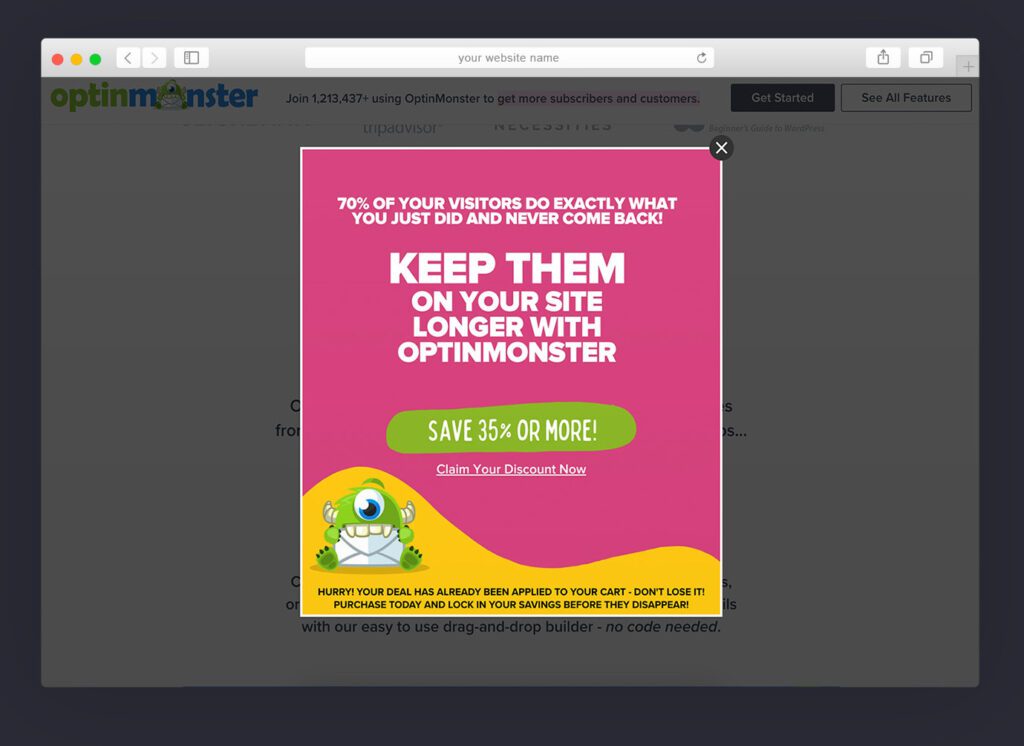

Second, program your popup to appear when users arrive on your website. We only like doing this when the offer is compelling or HIGHLY RELEVANT to users. For Blocks clients, we will utilize full-screen popups with a darkened background so we get the user’s full attention.
Third, use slide-in notifications (yes, not exactly popups, but very similar) throughout the website, especially on the web pages that receive the most traffic from search engines. There is a good chance users won’t visit your homepage and see your primary popup, so adding an announcement popup on these additional pages will put them in the know.
Social Proof Notifications
Even if you’re not familiar with what a ‘social proof notification’ is, you have probably seen one or more without realizing it.
Social proof notifications provide real-time proof of actions other customers have taken. For instance, if you’re capturing email signups, a social proof notification will pop up in the lower left-hand corner sharing information about how many people have signed up within the past day.
These social proof notifications do three things:
- Build trust in your offer by showing others are acting
- Increase the perceived value of your offer
- Instill fear of missing out on the offer, “Oh, they’re taking advantage, and I don’t want to miss out.”
These notifications are really ideal for businesses that may not have much brand recognition, or if you’re finding it difficult to get people to trust you with their information. A small message that communicates “people trust this company” can be all it takes to convince others to trust you as well.
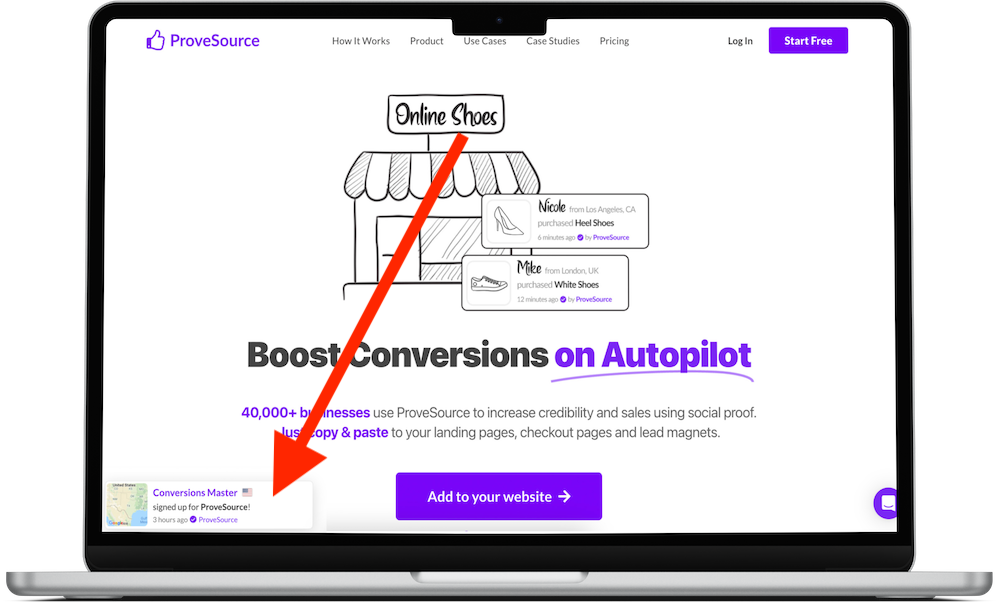

Campaign Donut has an excellent article on Social Proof Notification Apps providing options with pros and cons for each service.
Redirect Page (after your campaign)
This is easy to forget which is why we’re including it here. You need to have a page ready to go when your campaign ends.
While you can simply redirect to your website home page or your regular pricing page (and we do this very thing for Blocks clients), you can also redirect to a special page that offers some sort of consolation prize.
Perhaps the offer is expired, but you have a mini-offer you’d like to make. Redirect users to a page saying something like, “You missed the offer, but we have something just for you.” Using the same principles for creating your main offer, you can create this second offer.
- Save $xx off a monthly membership
- Get x months of access to our support group
- Buy a year, get x months free
- Sign up and get the ebook free
You don’t have to do anything special… but you must have a redirect in place. If you don’t, you’ll run the risk of losing customers’ trust because you didn’t do what you said you would… close off access.
Supporting Content
How are you going to deliver bonuses?
Where are you sending people to get answers to questions about the offer?
Do you want to use your webinar platform registration page or do you want to create a more unique and compelling webinar signup page on your website?
Whatever additional information you need to make available or special experience you want to create:
- Use your website to do the heavy lifting
- Use your website to convince people
- Use your website to eliminate the need for you to be replying to emails and answer questions
- Use your website to deliver goods
- Use your website to provide offer details
What supporting content will you need? You will learn over time. Because this isn’t the last time you’re going to run your offer, 😉 you will add more supporting content over time.
The best rule of thumb, for now, will be to anticipate the needs of your customers or the questions they will ask, then devise a way to use your website to meet those needs.
Campaign Launch Event or Webinar
There is no better way to kick off a marketing campaign than with an event. The benefits of running an event as your starting point are obvious.
1️⃣ People love looking forward to events. Anticipation in and of itself is enjoyable, but when you add the elements of socializing, breaking from the mundane or typical weekly routines, and adding entertainment to the mix, few things compare… at least in terms of launching your campaign.
2️⃣ Your company finds its way into personal calendars. When you host an event, that’s exactly what you gain access to!
3️⃣ There is no replacement for making a personal connection with your audience. An event puts you face-to-face with your customers. They see you’re a real company with real people who truly care about them succeeding! No better time to let them see you than when you’re about to make a great offer!
4️⃣ The audience of your live event represents a large chunk of your most interested buyers. Attendees will not be able to separate the strength of the offer from the presentation they experience. If your event is strong and compelling, every time they see the offer, they will be reminded of how their life can be better.
5️⃣ If you project a strong, confident, and professional appearance during your event this will elevate the overall perception of your brand and, as a result, the perceived value of your product. The event is your opportunity to build up your brand narrative and help attendees know what to think of your business and offer.
Just like Uncle Ben said to Peter Parker, “With great power comes great responsibility,” running a launch event is very powerful but must be planned and managed responsibly. If you show up on the event day with no planning, you will not only undermine the power of the event itself, but you will undermine your entire campaign.
Plan Your Launch Event Well in Advance
When the idea of your offer is born, planning for your event should begin. The more time you have to plan for your event the more time you’ll have to pull off your best ideas!
Our team plans several launch events per year; we start planning approximately 4 months out from the launch date for events that produce six-figure returns.
This buffer of time is an invitation to dream big with the reality that you could actually pull off some of your bigger ideas.
Essentials for Any Offer Launch Event
No matter what type of event format you run, here are the essentials that will set you up for success — and you DEFINITELY want to feel set up for success when you’re in front of an audience.
✅ Clearly defined event agenda
✅ Event walkthrough with everyone who is participating (like a table read)
✅ Dress rehearsal prior to your event (don’t practice at the event)
✅ Slides explaining your offer
✅ Call-to-action at the end of the event (usually a link)
✅ Questions to ask attendees
✅ Specified length of time
✅ Great webinar platform experience (we use our affiliate partner Demio)
✅ Support person in chat to answer questions
✅ Wired internet connection for the computer
🟢 Handouts (notes or other) for attendees (optional)
🟢 Giveaways to drive attendance and engagement (optional)
🟢 Predetermined set of questions to answer at the end (optional)
🟢 Supporting visuals (physical props) to help break up the scene (optional)
The amount of lead time you have for your event will drive much of what your launch event looks like. Again, if you plan your launch event well in advance, you’ll have more options and greater freedom to choose what your event looks like.
Slideshow Presentation Webinar
The easiest event you could run would be a standard webinar where you show up with a slideshow presentation and talk through each slide, sharing your offer at the end.
While there are things you could do to spice up the event, this is largely a routine and mundane type of event and is not an ideal format for a big offer launch.
Talking Head Webinar
Another type of event you could run would be the talking head webinar where, instead of a slideshow, a camera is on a person (and possibly a remote guest) the majority of the time. There may be some slides, and there may be some screen sharing, but this is a slightly different format than the slideshow presentation webinar.
The benefit of this format is the presence of a face throughout the event. If the presenter has charisma, has mastered the material, and has rehearsed their presentation, it is a huge step up. Of course, the opposite is true — if the presenter is boring, fumbling through notes, or appears unrehearsed, this will render your event a net negative.
Live Set, Live Hosts Event
The jump between a slideshow webinar and a talking head webinar is dwarfed by the jump between a talking head webinar and a live set, live host event!
This format offers multiple hosts, at least two, that are streamed live from a designated production set.
You can run this format with a single camera and is very similar to what you’d experience watching football pre-game shows with the single windscreen shot showing all the guests at the same time.
https://www.youtube.com/watch?v=a4eGC1l3AcI
Live Set, Live Hosts, High Production Event
The last and most elaborate event type that we’ll talk about in this article is a live, high-production event with multiple multimedia elements.
✅ Countdown Videos
✅ Opening Videos
✅ Lower Third Overlays
✅ Slideshows
✅ Music
✅ Multiple Cameras
✅ Switch to Produced Videos
There are more elements of a high production event that we could mention but the list above gives you an idea. Instead of just one single camera on all hosts at the same time, you’ll be looking at multiple cameras with multiple angles.
These are a lot of fun to pull off and are, by far, the most complex. A produced event requires the most planning, the most equipment, the most power in a computer, the best lighting, and so on. They can be incredibly effective but they can also be incredibly costly and time-consuming.
If your company is naturally gifted at running big events, it may be the format for you. However, if you’re just now venturing into live events or you are flying solo to make the event happen, simpler is better.
Launch Event Equipment
Equipment will not ‘make’ your event, but it can ‘break’ your event. You can do everything right and check off everything on your list — and if the audio is distorted or crackling, it’s all for nothing.
It’s unfortunate that technical difficulties derail great presentations, but it doesn’t have to be the case for you.
While there are some things you’ll never be able to avoid (a power outage in the middle of your event), planning for the things you can control will ensure that your event goes as planned, barring something truly unforeseen or an act of God.
Here is a list of the equipment you’ll want to invest in to make sure your event goes smoothly.
✅ Modern computer with at least 16GB of RAM
- Any current Apple computer with 16GB of RAM is sufficient
- MacBook Pro 14”
- MacBook Air
- iMac must be ordered special from Apple and configured for 16GB RAM
✅ External microphone — do not use your computer microphone
- Blue Yeti — for individual
- Rode NT-USB — for individual
- Elgato Wave:3 — for individual
- Rode Wireless Go — for multiple hosts (up to 3)
✅ External webcam — using an external webcam is a big upgrade
- Logitech c920 — for individual use (budget)
- Elgato Facecam — for individual use
- Lumina 4k Webcam — for individual use
- iPhone Continuity Camera — Desktop Mount, Laptop Mount — for individual use
✅ External lighting — use a ring light if it’s just you and your computer
- Personal ring light with cold & warm tone
- Elgato Ring Light
✅ Wired internet connection — if at all possible, do not use wifi
Recommendation for Your Launch Event
Do any of the event formats above sound like a fit for your company?
Our recommendation is to start small and work your way up. The companies that succeed at the most elaborate events have built their way up. Sitting in front of your screen presenting a webinar can be done solo. Anytime you replace your webcam with a more official camera you multiply the necessary people by AT LEAST 2… if not four or more.
Start small, get good at producing small, simple events, and you’ll begin building muscles to do the heavy lifting required for more complex, multimedia-rich events.
Campaign Email Marketing Strategy
Your email list is the primary audience for your offer. These are people you have control over whether or not you contact them.
⚠️ You have 0 control over website visitors.
⚠️ You have 0 control over social media users.
⚠️ You have 0 control over ad networks.
✅ You have 100% control over when your subscribers receive a message.
While you can’t force anyone to open your emails, you can make your subject line and pre-heading so compelling they are enticed to open, read, and take action.
This being the case, let’s put together an email marketing strategy that will work for your campaign.
Pre-Pre-Campaign Email Sequence
Before we talk about the pre-campaign email sequence, it is worth noting that at Blocks we advocate for what we call the Nurture the Sale Newsletter. Without taking time to get into this, you can learn more about this strategy and why it works by listening to the Nurture the Sale Newsletter episode from our podcast, The Donut Shop Online Marketing Podcast.
If you have not regularly emailed your list you CANNOT begin regular communication by making an offer.
You can’t.
Your campaign will fall flat on its face.
So, you need to begin communication with your list by adding value to their work.
This is where a pre-pre-campaign email sequence comes in.
With your campaign theme already selected, you’re in a great position to build a case for subscribers to take you up on your offer.
“Building the case” is the lens through which you write all of your pre-pre-campaign emails. Here are the questions you need to consider as you think about a series of pre-pre-campaign emails.
- What problems do your customers face?
- Where do they encounter resistance?
- How are they currently struggling – not using your product or service?
- Are there simple solutions they can implement which would make life easier and their business more profitable?
- What low-hanging fruit exists in their industry that they are unaware of but are equipped to harvest?
Several things need to happen before you can start pitching your list and this sequence of emails checks all the boxes.
- Build a relationship with your subscribers.
- Help subscribers become used to seeing your name in their inbox.
- Train subscribers to open, read, and respond to your emails.
- Help your subscribers achieve quick wins.
- Encourage your subscribers.
- Demonstrate your authority in the industry.
- Position yourself or your company as an industry expert.
- Get subscribers wondering what else you have to say.
- Inspire subscribers to take action.
- Generate unsubscribes from people who aren’t interested in you or your product.
If you go from never connecting with your subscribers to immediately pitching your offer it won’t work.
If you don’t like this type of email marketing, why would anyone else?
So what should this pre-pre-campaign sequence look like? How long should it be? What should I say?
Here are some ideas for writing out your pre-pre-campaign sequence.
Begin Emailing Your List At Least 2 Months In Advance
If you are not actively emailing your list, start right now. This could be a weekly newsletter, weekly updates, weekly opportunities, weekly roundups… whatever you choose… begin doing it weekly and be consistent.
Ideally, you’ll be emailing your list weekly at least 6 months in advance. If you only have two months until you MUST run your offer, that’s fine, just know that the next time you run your offer, you’ll have a warmer list.
Sample Email Sequence 2 Months Out
You are going to be in the best position to know what to say to your list. Still, here is a suggested sequence you can use to inspire your own emails.
Email 01, 8 Weeks Out — Have you seen this?
This email will point to your best freebie. Maybe this is a pillar page on your website. Maybe this is your best ebook. Maybe this is your most-watched video.
Whatever you have that is free and customers have found incredibly helpful, this is what you want to send a link to. Talk about their success, talk about their hopes and their dreams, and talk about how life is on the other side… then add in “And this _______ is a great place to start!”
Email 02, 7 Weeks Out — Minor change with a major impact
Showcase one way your subscribers can improve their business without much effort or investment. Give an example of where it’s worked, even if it’s not an example from your customer base, so they can see what was done and what the end result was.
Provide a link to either the example or a resource on your website (article or video) that explains the minor change and provides evidence of the result.
Email 03, 6 Weeks Out — Feature highlight
Make this email about showing off features from your service or product that may not be common knowledge… even if it is common knowledge, show how it can be used and what difference it makes.
Email 04, 5 Weeks Out — More product highlights
Whether you want to share a demo, showcase a user and their success, or continue to explain different features, this email is another opportunity to highlight the problems solved by your business. Find a wound your subscribers have, expose it, and then hold up your product as the medicine.
Do not sell. Just empathize with your subscribers. Do not sell.
Email 05, 4 Weeks Out — Point to media
If you have a podcast, tell them about one episode they’ll appreciate.
If you have a YouTube Channel with great videos, tell them about your top video (if it’s relevant).
If you have a great social media channel with lots of activity, share it.
If you have a community they can join, tell them about it and provide a link.
Bottom line: share something that will get subscribers more involved in your ecosystem.
Email 06, 3 Weeks Out — What you do matters
Use this email to start building up the confidence of your subscribers. Talk about how important their work is. Point to examples of how their work has made a difference. Encourage them to not quit or give up, giving pointers for how to find inspiration even if they’re not feeling like what they do matters.
Point to case studies on your website talking about how the work makes a difference. Let them know you’re rooting for them and want to see them succeed.
Email 07, 2 Weeks Out — What if…
This email starts looking to the future. Painting a picture of what life is like over the horizon. What are your subscribers wanting? What will success in your industry produce for them? How will their lives change if the promise of your product rings true?
To be clear, you’re not pitching your product here. You are pitching the results of your product (not even mentioning your product).
📊 If your product is an analytic app… you’re pitching how great life is when you have easy-to-understand analytics.
🍎 If your product is a nutrition coaching service… you’re pitching effortless meals that everyone loves.
🛍️ If you are an e-commerce shop selling animal equipment… you’re pitching the joy of owning an animal that is healthy and happy, and the joy a happy and healthy animal brings to all those around you.
Do not pitch your product. You can talk about how, “Being in the ________ industry, we see this all the time…” but you’re not making your pitch just yet. You’re building goodwill.
Email 08, 1 Week Out — A question…
This is your final email before you go into your launch sequence. This email can directly relate to your launch sequence or it can be separate. Our approach is to connect it and ask one question that gets subscribers thinking.
Ask a question that is simple to answer but makes them think. Write the email as if you’re writing a friend or a trusted colleague who has requested your help.
Relational. Empathetic. Encouraging.
NOTE: Deliver these emails as ‘text’ emails… not visual emails. It’s tempting to use visual emails with headers, graphics, lines, varying fonts, etc. Do you know who sends those types of emails? Huge, faceless corporations. What type of email does family send to one another? What type of email do you send to friends? What do the emails look like that you respond to every day… Text. Write text emails.
Pre-Launch Campaign Email Sequence
When you have a warm list you can begin sending your campaign pre-launch emails. These are the emails that will begin to frame your eventual offer in a positive light.
The easiest way to explain this would be to use something we’re all familiar with… New Year Resolutions.
Let’s consider a personal trainer that wants to launch a New Year special. The trainer knows that come the first week of January, everyone will be ‘feeling the holidays’ around their midsection along with a level of guilt for not following through on previous resolutions. Many people will look to exercise and nutrition for answers.
The pre-pre-launch campaign may be encouraging messages leading up to the holiday season. Suggestions for alternative recipes, exercise routines you can follow while traveling, etc.
The pre-launch campaign emails will start by talking about the problems everyone reading it is already facing.
Here is a list of suggested emails to run for this type of pre-launch campaign.
Email 01 — There isn’t a problem with you… the problem you have to solve is “Now what?”
Email 02 — Here are 3 options for solving the “now what?” problem.
Email 03 — What hasn’t worked in the past? Why? Want to know how to make the future different?
Email 04 — A different future begins with a different start.
Email 05 — What’s going to come between you and the start… and how to overcome.
Email 06 — Accountability and community is the difference.
Email 07 — Be on the lookout next week for something I think you’ll like.
Email 08 — Tomorrow is the day.
The number of emails you run will be reflected in how much your offer costs. The more your offer costs, the more emails you’ll run, with the opposite being true. You’ll want to start this sequence at least 3-4 weeks before your offer goes live, leaving time for more emails if it’s a more expensive offer.
This pre-launch concept is following a formula made popular by, guess who, Jeff Walker.
Propose a problem, solve the problem, and submit a second problem.
Restate the second problem, solve the problem, and submit a third problem.
Restate the third problem, solve the problem, and submit a fourth problem.
Restate the fourth problem, solve the problem, submit a fifth problem… propose your offer as the solution.
This formula has worked for thousands of entrepreneurs, business owners, marketers, and people who have no business writing emails.
And it can work for you, too!
There are three elements you’ll want to get right:
- The overall narrative of the emails.
- The number of emails you send.
- The schedule of the emails.
In theory, a lower-priced offer will require fewer emails and a higher-cost offer will require more emails. This isn’t universally true, but in our experience at Blocks, our highest-grossing launches have correlated with the number of emails we sent in our pre-launch email sequence.
If you’re doing a signature event such as a webinar or live stream to promote your product and kickoff the offer promotion, you’ll want to include invitations to the event intermingled with these emails. We recommend at least one HTML-style email with lots of imagery — in our experience, these receive more registrations than text-based emails.
Your goal with this sequence is to poke holes in your client’s work and then provide a solution to fix each hole. With the last hole, point to your product or service as the solution to fix the hole.
The sequence is incredibly important and if you bypass this sequence you’ll miss out on sales.
Sales Email Sequence
This is where you drive revenue. This email sequence is where you put the pressure on. Without this sequence, all your work is for nothing.
The sales email sequence is where you actually sell your offer and remind your subscribers how great your offer is. Whether you run a launch event like a webinar or live stream or if you omit doing a live event and release your offer via email, this sequence is where you go in for the sale.
Gary Vaynerchuk has a book called Jab, Jab, Jab, Right Hook: How to Tell Your Story in a Noisy Social World; this email sequence is your right hook.
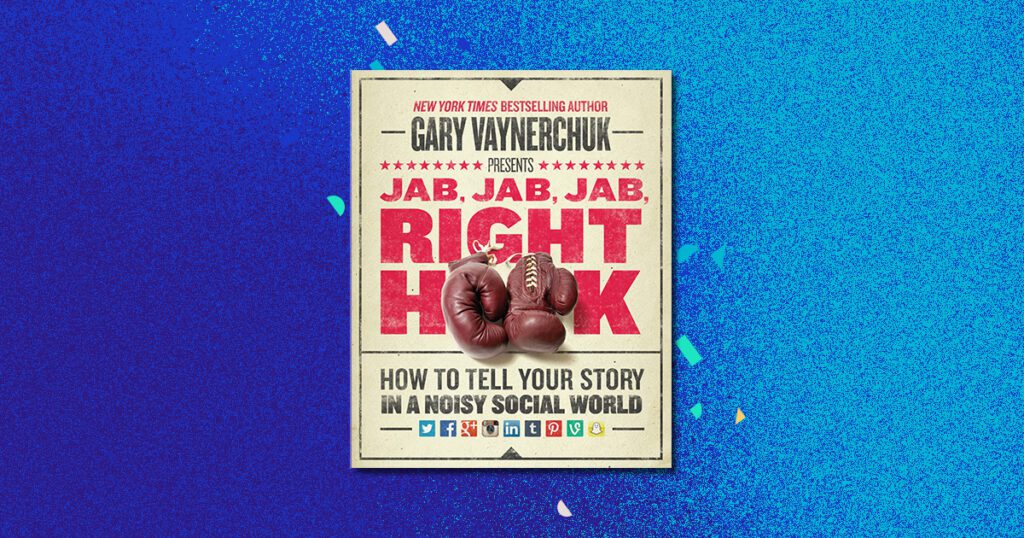

For this email sequence, you need to think about every possible excuse or objection someone might have to make a purchase and draft an email to punch back.
“Does this really work?” — Send an email with nothing but testimonials.
“What do I get?” — Send an email focusing 100% on the bonuses.
“What does this product actually do?” — Send an email explaining your product or service.
“Why do I want this bonus?” — Pick the best bonus and write an email about how transformative it is.
“How long do I have?” —Add a countdown timer to every email!
“Why should I buy now?” — Send an email that puts pressure on why this is a great time to buy.
Depending on your industry, product, and customers, you will have some of these questions to answer as well as additional questions to answer. The important thing is to have deep care for your customer, anticipate where they are and what they’re thinking, and write emails to give them every opportunity to say ‘yes’ to your offer.
Sample Sales Email Sequence
With that said, here is the starting point we use for every sales email sequence. We may add or subtract from this sequence, but this is where we start for every sales email sequence.
Your sales sequence began with your launch event, you revealed the offer at the end and now the first email you send is following that series of events.
Email 01 — Sales email focusing on the bonuses (goes to everyone who attended your offer launch event)
Email 02 — Link to the replay and includes information on the big offer! (goes to everyone who didn’t attend)
Email 03 — Product highlight… explain the product and why it’s amazing, mention the offer
Email 04 — Signature bonus highlight… pick the best bonus and explain it
Email 05 — Testimonials
Email 06 — Final Day
Email 07 — Last Call
Here are five of the most commonly asked questions about this email sequence, plus one additional instruction.
❓ How long should each email be? As long as it needs to be to make the point. Be discerning.
❓ Do I include images? Yes, include the offer mockup image where relevant.
❓ Who is the email from? There is no right answer. Just be intentional. It could be from the company, it could be from the host of the event, it could be from the owner, it could be from the founder. Be intentional and be consistent.
❓ How many emails should I send? This depends on how long the offer is available. We typically do one email per day while the offer is available.
❓ How long should my offer run? One week is a great starting point… Any longer and people will forget… Any shorter, you don’t accommodate the weekly schedule of all your subscribers.
✅ Here is what is included in every email:
- Button with link to sales page
- Countdown timer
- P.S. Section (people pay attention to these)
- Non Button link to … the actual URL
If you’re looking at this list thinking, “Wow, this is a lot of writing,” you would be correct. It is a lot to write and this is why so many people do not cross the finish line when it comes to their marketing campaigns.
You cannot stop short at any of these mile markers. It is more important to do them 50% and push the campaign across the finish line than to try and write every email 100% perfectly but fail to send some of the messages.
Tips for Writing Your Launch Emails
Emails represent the backbone of your communication throughout the launch and these emails will directly impact your sales.
With that in mind, here are a few tips for writing emails that are engaging and effective.
Brainstorm Your Messaging with Others
Coming up with a narrative to weave through all of your emails will give you a much-needed pathway to follow. If you’ve ever gone hiking you know the path you choose determines what kind of hike you’ll have. In other words, it provides a guide to predictability. You want the same thing for your emails.
Choose a path to follow and make sure each email stays on the path.
Brainstorming with others allows you to go beyond picking predefined paths and blazing your own trail… A trail that is designed specifically for the wants, needs, and desires of your audience. Other people in the room will speak up and push back against your ideas, either helping you decide an idea isn’t worth pursuing or developing your idea into a more powerful and influential version. Other people are your secret weapon when crafting a narrative.
Our writers have developed launch emails with and without a strong narrative. With a strong narrative, emails are completed ahead of time – they are easier to write, and each email clearly compliments the next email. Without a strong narrative, emails are written last minute and the connection between each one is more difficult to see.
Have Someone Proof Every Email
Do not send your emails without having a second person review them. Not only will that person catch spelling and grammatical errors, but they will also point out where the emails don’t make sense or are confusing. Another set of eyes (at least one, if not two or three) catches the worst parts of your emails and helps you make the best parts shine.
Take Time Writing Your Subject Lines
The problem with using social media during a campaign is you cannot force a social network to show your content to your followers. You do not get to determine who sees what.
With email, you can determine with 100% accuracy who receives an email.
And while you can’t force someone to open and read your message, you can influence their action with a great subject line.
When you’ve drafted your email, spend 10-20 minutes on your subject line. Here are a few tips for writing a compelling subject line.
- Make your subject line informational and mysterious
- Try and limit your subject line to under five words
- Mix up your subject lines to keep your subscribers from tuning out
- Use re: in your subject line when relevant (do not overdo this)
- Split test your subject lines using your email service provider (we use Drip)
- Reuse some of your top-performing subject lines from the distant past
You can read our other article on subject line best practices to get more training and instruction on writing effective subject lines that compel people to open your emails.
Paid Ads for Your Marketing Campaign
Paid ads do have a role in your marketing campaign, or rather, can have a role in your marketing campaign. Because paid ads are incredibly nuanced from network to network and from objective to objective. Give careful consideration to how you use them, how much you spend, and who you target.
Why?
Consider this.
You are running an ad for a $197 offer and that ad shows up in front of someone who has never heard of your company and doesn’t see a need for your product. This is essentially a waste of money. If it were just one person, that would not be a huge deal. Except with social and search ads, it’s not just one person. It’s thousands if not hundreds of thousands of people seeing an ad that is irrelevant.
Maybe the product is relevant but they have no familiarity with your company.
Maybe they’re familiar with your company but they have no context for the offer.
Can you see now how running ads could be a huge money suck that doesn’t provide any type of monetary return — at least not to ad campaigns that are promoting your offer?
How do we use paid ads effectively for our campaign? We have four types of paid ad campaigns you can run and each one is itemized below.
Since this article isn’t a tutorial on running effective paid ads don’t be surprised if you wind up having more questions than answers… that’s okay. There is a lot of great training on how to run effective paid ads.
Without going into great detail, we will simply say that these are the campaigns you should consider running, and the audiences you run them for will be important.
Campaign Offer Paid Ads
Of all the paid ads you can run during your marketing campaign, the ad set that belongs in your plan of action is the one that promotes your offer to subscribers (and if applicable, your event registrants).
This is a HUGE opportunity and one that you shouldn’t miss.
And while this ad set comes last in the timeline, we’re talking about it first because it is the most important (should you choose to run paid ads).
You’ve run a pre-pre-launch, you’ve run a pre-launch, you’ve hosted an event, and now you’re emailing your list every day during your launch…
And when they log on to their social network account, they see your ads with a solution to the same problems they considered in the emails.
They see your ads with the same offer you pitched at the end of your event.
And they see your ads with the same offer they’re reading about every day in their email inbox.
Here are the principles to follow for your offer ads.
- Target ads exclusively to those on your list. This would be a custom audience.
- If you want to expand a little, target ads to anyone who visits your sales page.
- If you want to expand even further, target ads to anyone who visits your website.
- Optimize your ads for purchases (not clicks, impressions, or any other objective).
- Begin running your ads immediately upon making your offer available.
- Install the purchase event for each ad network on the page immediately following checkout.
- Design graphics inspired by your signature graphics, including mockups.
Essentially, you want to make it so the people on your list can’t get away from your offer. It’s following them everywhere. Essentially, you want to ‘give them the sign’ they’ve been looking for.
You could even make that one of your ad headlines “Here’s the sign you’ve been looking for.”
Awareness Paid Ads Campaigns
Truthfully, this is the ‘style’ of ad you may want to consider always running. Building a general awareness of your business and products regardless of what offer you’re running. With an awareness campaign, your goal is to introduce your company to a new audience with the desire that they will recognize your brand or product in future ads or during future conversations.
While an awareness campaign WILL NOT help you directly during a campaign, you can include it in your marketing plan of action.
“Let’s get our awareness ads campaign running now so when we get closer to launch we can run a lead magnet campaign to gain the email addresses of people already familiar with us.”
Using videos in your awareness campaign is a great way to prep an audience for the future because most ad managers will allow you to create an audience based on who watched a video from a separate campaign.
Lead Magnet Paid Ads
You want email addresses. You need email addresses. Why? Because your list is the audience for your marketing plan of action. If someone is on your email list, one if not several of the following things are true:
✅ They are within your target customer demographic
✅ They are interested in what you have to offer on some level (whether they want it from you or someone else)
✅ They are familiar with your company
✅ They are familiar on some level with your products or services
✅ They can benefit from your products or services
Lead magnets are a tried and true way of attracting people to sign up for your list and promoting your best-performing lead magnet through social paid ads will help you build your list very quickly.
If you’re not familiar with lead magnets the concept is pretty straightforward.
Lead magnets represent a tool used to attract potential customers by offering something valuable in exchange for contact information… usually an email address. This “magnet” is typically a piece of content or a resource that appeals to the target audience’s interests, needs, or pain points.
The goal isn’t to get email addresses… the goal is to gain targeted and specific leads that can later be converted into customers.
No matter when you’re going to run your marketing campaign, your larger marketing plan of action should include list building by promoting your lead magnet through paid ads.
In addition to using the targeting options inside each ad manager, there are two audiences you’ll want to target with your lead magnet offer: people who have engaged with your awareness campaign and people who have visited your website but are not already on your list.
Securing subscribers for your email list from these two audiences will give you a steady stream of qualified buyers for your next campaign and, if you keep the campaigns running and optimized, all future campaigns!
Pre-Campaign Paid Ads
Running ads for the express purpose of promoting your upcoming campaign is not something that has to be done. Serious digital ad agencies have strategies for effective pre-campaign ads, but truthfully, you’re doing little more than running an awareness campaign targeted specifically to people who are already on your list.
If you do want to run pre-campaign ads, here are some guiding principles to consider:
Current Subscriber Custom Audience
Create a custom audience in the ads manager based on your current email subscribers to use as one audience.
Run Ads Two Weeks from Launch
Start running these ads at least two weeks out from the launch date. It will take the ad network several days to optimize the ads. In order to get any impact, you’ll need to see the campaign through that optimization period.
Use Minimal Creative
Use minimal ad creative to help speed up the optimization process. If you usually do a lot of split testing, it adds time to the optimization process. It is better to pick the creative you feel best about (or the creative that has performed best in the past) and start running ads with that creative.
Website Visitor Custom Audience
Create a custom audience based on people who have visited your website in the last 30 days. You could expand this to 60, 90, or more, but 30 is a good starting point. The assumption here is that someone who has visited your website has some level of familiarity with your brand and they might be interested in what you’re about to announce.
People who don’t know about your company and are unfamiliar with your brand don’t care about your campaign. Sure, you may miss out on a few fringe customers, but you have to pay real dollars to reach the masses in order to attract that fringe customer. They’ll find you… don’t break the bank trying to help them… at least not with this campaign.
Event Registration Paid Ads
When we were brainstorming this article we weren’t going to differentiate Event Registration Paid Ads from Pre-Campaign Ads. However, they are uniquely different; not separating them into two separate sections could mean leaving ROI on the table.
While Pre-Campaign Ads talk about the upcoming campaign (or the narrative around the campaign), Event Registration Paid Ads are generating awareness for the campaign… they are getting people engaged in the campaign.
Running a launch event or webinar, you’re giving people something to plan for, something to get excited about, and something to act on. With general awareness campaigns, there isn’t much someone can do other than see the ad and try to remember it. With an invitation to an event, they can sign up to attend and get their tickets.
Not only does this option give people an opportunity to engage with the campaign, it organically creates an audience who will be anticipating your offer at the end of the event and will, theoretically, be ready to buy.
Yes, there is more effort involved with running an event.
Yes, you’ll need to be prepared ahead of time with an agenda.
Yes, it does require a live element (even if you’re using pre-recorded content).
Yes, there are more logistics to manage.
But the benefits can easily outweigh the negatives.
✅ Anticipation for your event.
✅ Customer engagement.
✅ People planning to spend time with you.
✅ An audience for your offer, baked in.
✅ Face to face interaction with your customers.
As it relates specifically to paid ads, when you run an event you can run ads to a greater demographic before your campaign launch.
An event serves as a highly effective lead magnet. People who are not interested in your brand or products may be interested in the theme of your event and, therefore, will register.
If you do run ads for an event or webinar, here are audiences you’ll want to consider:
- Visitors to your website in the last 90 days.
- Current list subscribers.
- A lookalike audience of your customer list (not all your leads, just customers).
- A lookalike list of your most engaged list subscribers.
As much as it sounds like this type of ad campaign is a win, and it definitely can be, remember that every dollar you spend eats into your overall profits… so be strategic.
But yes, the potential to expand your audience beyond your current list is significant when you decide to use events in your launch strategy versus just opening the offer.
The Opportunity for Paid Ads
Every business is different, every audience is unique, and every offer converts differently. This means paid ads may be a good idea for your launch but it’s impossible to say with any certainty in an article like this.
You’ll be the person in the best position to determine if ads will be a good investment.
The main takeaway from this section is not “to run ads or to not run ads” but rather, what kind of ads you could run and how to make those work best for you should you decide to incorporate paid ads.
Social Media Campaign Posts
Social media falls into one of two categories… vanity or community.
Likes, comments, shares, and follows feel great and are encouraging to see but they don’t pay the bills. This is why they’re called vanity metrics. They don’t produce much of a return other than an emotional high. For this reason, social media doesn’t play a substantial role in most launch campaigns.
For those businesses that have done a good job of building community through their social media channels, posting organic content will have a much stronger impact on the final sales.
Because most companies are in the former category of vanity, that’s where we will put our attention to social media in a marketing plan of action.
You need to get one thing in your head: posting on organic social media will only add to your campaign’s impact… it will not create impact.
Do not put any trust in social media.
Do not look to social media to produce traffic to your website.
Do not make social media the focus of your effort.
Do not equate any past clicks, shares, or likes as a predictor for sales.
Any results from social media should be considered a cherry and whipped cream on your ice cream sundae.
Why You Should Post On Social Media During All Campaign Phases
As bearish as you should be regarding organic social media as a campaign centerpiece, you should be very bullish on using your social media profiles as a ‘newsfeed’ for your campaign.
Here are a few reasons why you should post regularly on social media during the campaign.
People Will Want to Know What You’re Up To
Are you familiar with the “frequency illusion”? This phenomenon is when a person learns or becomes aware of something new, and suddenly starts to notice it everywhere. For example, you decide to purchase a red car and all of a sudden your brain becomes more attuned to noticing red cars, leading red cars to appear more frequently in your perception.
When you start running your pre-pre-launch emails, or your pre-launch emails, or even your campaign launch emails you are putting your company on the radar of your subscribers. Now that they’re aware that you’re ‘up to something’ they will be curious to discover ‘what you’re up to.’
This frequency illusion works in your favor. When they’re looking for more information, where will they go? One of three places:
- Your website
- Their mail inbox
- Your social media profile
When they arrive on your social media feed you want to make sure everything you’ve ‘been up to’ is right in front of them.
If there are no likes on your posts… that’s okay. If there are no comments… that’s fine. If there are no shares… no worries. The point here is that you are active and in their mind, that legitimizes the offer. Sure, if there are likes, comments, and shares, that’s great social proof. But at this point, they’re not coming to your profile for social proof… they’re already interested… they’re coming to your feed to see if they’re missing something.
Post regularly with the mentality that if someone is looking for details, they’ll be able to find everything they need to know on your social feed.
You Have Nothing to Lose
Posting on social media should be the absolute last thing on your action items list when preparing for your campaign. And because it’s last, that means you will have written all of your emails, web copy, ad content, and created all your graphics… just repurpose the content for each network.
You can even use AI copywriting to help come up with your content.
Go to your sales page and copy all of the text from start to finish, omitting any text that you deem irrelevant or not necessary to a social media post.
Visit ChatGPT and paste this prompt into the chat dialogue:
Take this information and turn it into four different social media posts:
Before you hit return, paste the copy from the sales page and then ask ChatGPT to generate the results.
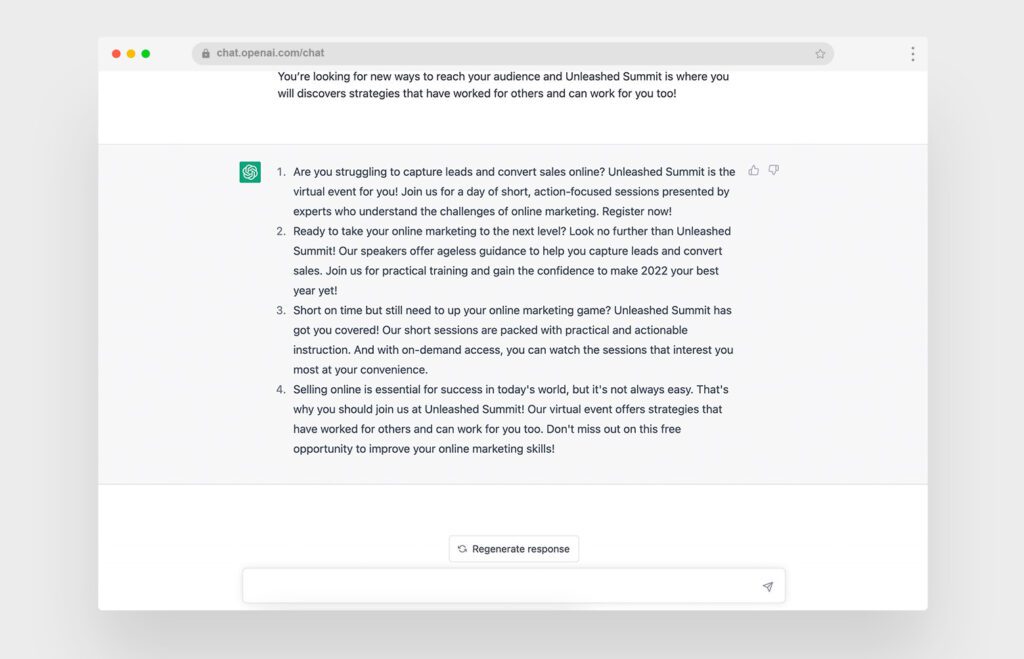

What You Should Post On Social Media
Deciding what you should say is probably going to take the most time. Here are several prompts you can use to help you plan your posts.
Pre-Campaign Social Media Posts
- Summarize each email into a short post.
- Post invitations to join your newsletter to receive the ‘great series we are sending on the topic of _______.’
- Links to articles and content relevant to the theme of your launch.
- Synthesize the replies you receive to your launch emails and then share that sentiment in a post.
- Content foreshadowing about ‘something we’re truly excited to announce in the coming weeks.’
- Incorporate testimonials about the product or service at the center of your offer.
Campaign Launch Social Media Posts
- Offer announcement with all the details and a link back to the offer sales page.
- Countdown posts periodically, not every day… ‘four days left’ or ‘today is the last day’.
- Individual posts highlighting the individual bonuses included in the offer.
- Testimonials that highlight the value of your product or service in the context of your offer.
- Link to watch the replay of your launch event.
- Additional posts that highlight the offer with mockup images.
These are just a few ideas to get you started. Use the list as is or come up with your content types. Whatever you wind up posting, make sure to save the copy because the next time you run an offer you can recycle your posts from this initial strategy.
Bonus Ways to Use Social Media
For those who just love social media, you can leverage these additional ideas into your marketing plan of action.
Sharing Videos via Social
If any of your marketing emails refer to a video, instead of publishing the video on your website and guiding people there, you could post the video on a social media profile and direct people to view the video there. The social networks will look at this engagement as a social signal and that could provide a favorable boost to your content.
Reusing Your Best Content From the Past
You can very easily go back into your post archives and pull out the content that performed the best, recycle that content into new content that supports your offer, and publish accordingly. This is a great way to avoid having to create brand-new content yet publish content that is relevant and engaging at the same time.
Leverage Trends Into Your Social Content
This one can be a little dicey because you don’t want to come across as ‘trying too hard,’ but if you’re looking for content ideas look at what is currently trending on various social networks. Look at what sounds are trending. Look at what themes are trending. If any of the trends are relevant and within your wheelhouse, this could be a great starting point for creating additional content.
Campaign Launch Event or Webinar
There is no better way to kick off a campaign than with an event. The benefits of running an event as your starting point are obvious.
1️⃣ People love looking forward to events. Anticipation in and of itself is enjoyable, but when you add the elements of socializing, breaking from the mundane or typical weekly routines, and adding entertainment into the mix, few things can compare… at least in terms of launching your campaign.
2️⃣ Your company finds its way into personal calendars. There are few places a business can find itself in that are more intimate than a person’s calendar. When you host an event, that’s exactly what you gain access to!
3️⃣ There is no replacement for making a personal connection with your audience. An event puts you face-to-face with your customers. They see you’re a real company with real people who care about customers succeeding! No better time to let them see you than when you’re about to make a great offer!
4️⃣ The audience of your live event represents a large chunk of your most interested buyers. Attendees will not be able to separate the strength of the offer from the presentation they experience. If your event is strong and compelling, every time they see the offer, they will be reminded of how their life can be better.
Measuring the Success of Your Marketing Plan of Action
When we think about measuring the success of our work, there is one metric that comes to mind.
Money.
Let’s say you’re running a real campaign for the first time and you’re unsure of what to expect by way of sales. Looking exclusively at your sales number may not fully reveal the impact of your work. For instance, if you’ve had a cold list for a long time and you run a campaign that only converts 1% of your audience, you can still look at other metrics to reveal the type of interest you drew and the type of momentum you created.
The metrics you identify as your indicators of success will be called Key Performance Indicators or KPIs for short.
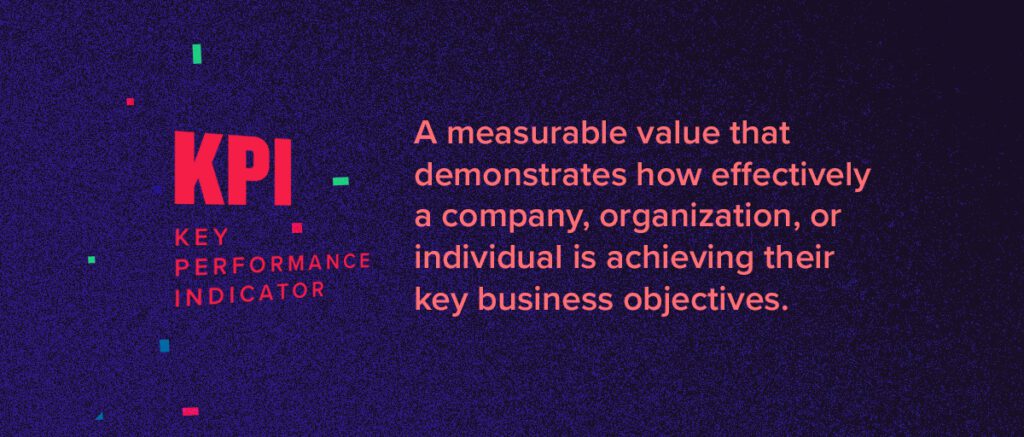

The KPIs you choose will largely be dependent on your business model, the level of marketing activity prior to your campaign, the length of your sales cycle, the number of new leads versus older leads, the cost of your product, and maybe several other industry or company-specific metrics.
Here are generic metrics you can use to start the conversation with your team and shape the metric cocktail you want to create.
- Free Trials
- New Subscribers
- Monthly Recurring Revenue Added (MRR)
- Overall Gross Revenue During Sale
- Overall Net Revenue During Sale
- Event Registrations
- Event Attendees
- Conversion Rate (sales page visits vs purchases)
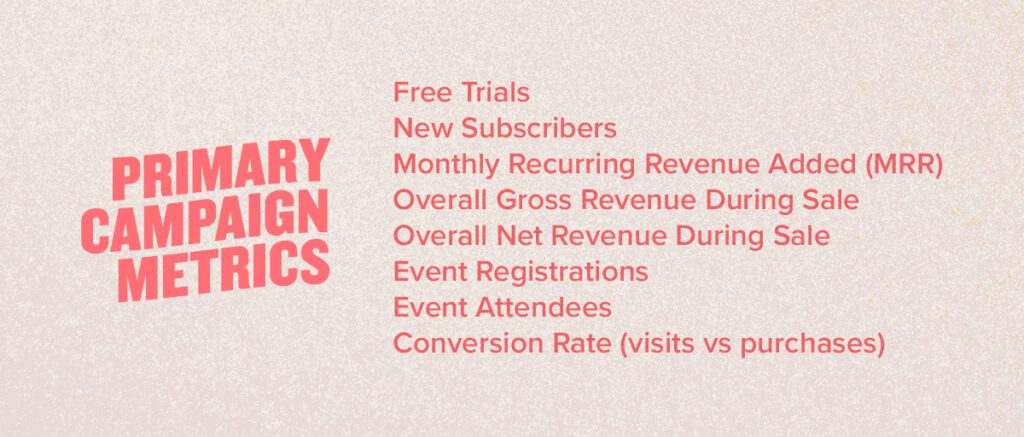

You might not get the sales you want and in that case, you can explore the following metrics to help you see the progress you created with your marketing plan.
- The number of subscriber increases you experienced during the campaign
- Email send rate (how many emails sent)
- Email open rate (number of emails sent against the number of emails opened)
- Email click-through rate (number of emails opened against the number of users who clicked in an email)
- Sales page users (number of people who visited your sales page)
- Sales page time on page (amount of time, on average, spent looking at your page)
- Overall website user rate (number of people who visited your website)
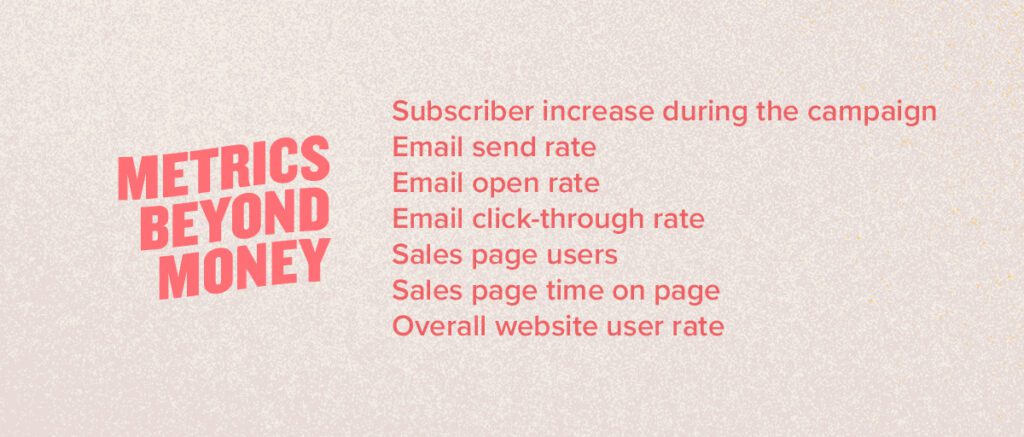

Run Your Marketing Plan of Action Multiple Times for Maximum Results
This should not be the last time you run this particular marketing plan of action. The temptation is to look at the results and if they’re less than what you expected (which is typically unreasonable), you can infer that the campaign was “not a success.”
It’s why identifying your KPIs ahead of time is important, especially when executing this marketing process for the first time.
Failure to run your plan a second time cuts your marketing department off at the knees because it fails to capitalize on the goodwill you’ve earned, the interest you’ve drummed up, and the brand awareness you’ve created.
Consider the following things that are true when you run a strong marketing plan of action:
✅ You made your company known to people who previously hadn’t heard of you.
✅ You educated email subscribers about your products and services their benefits.
✅ Your authority in your industry has increased through your educational posture.
✅ Potential customers who considered your offer but did not purchase will not get a second chance.
✅ Potential customers who are ready to buy but not ready to use your products and services don’t get to say ‘yes’ when the time is right.
✅ The mistakes you made the first time around won’t be corrected for improved results.
✅ You lose the chance to double down on the things you did right to help your company shine.
This is a SMALL list of what you lose when you choose not to run your campaign a second time.
If all this is lost, why would anyone ever quit after the first time they tried a real marketing plan of action?
Emotion.
Our agency has coached hundreds of entrepreneurs and small business owners, and the ones who are most successful are those who are not emotional about results, but pragmatic. It is possible to evaluate the results of a disappointing campaign without emotion and be able to identify strong elements to build the next campaign.
But let’s go one further.
What if you made more money through running your first real marketing campaign than you had previously with all your emails or social media posts? Is the temptation to quit still real?
Absolutely.
Why? Because running a marketing plan of action is challenging and not everyone is willing to work hard, no matter what the results could mean for their company.
We’ve worked with multiple clients who made 10x, 30x, and even 50x more revenue over their normal monthly earnings after running one campaign and insisted it wasn’t a success. Emotion is a big reason for their thinking.
✅ They worked harder than they ever had and expected more.
✅ They didn’t enjoy the amount of writing and admin work they had to perform.
✅ They wanted results immediately, rather than waiting multiple weeks for the plan to build momentum.
✅ They were able to compare ‘that one time’ when they ‘sent one email and sold xxxxx number of
dollars’ (but still haven’t been able to repeat it).
✅ They don’t want to sacrifice their lifestyle to build their marketing department
✅ They spent more learning how to market than they made through their campaign.
✅ They became distracted by another “great idea” and lost interest.
Embed this post https://www.instagram.com/p/CqBEQ55oImP/
The list of reasons someone quits after the first try is endless because humans are not rational, they are emotional. It gives you great insight not only into yourself but also into the people you’re trying to connect with and sell to.
You are not rational. They are not rational. You must figure out how to continue to motivate yourself to improve and grow in executing a plan of action despite the feelings you have about the results.
In the same way, you must figure out how to motivate your leads and subscribers to continue to improve their lives, using your products and services as the means.
Run your campaign multiple times and you will see, over time, the results begin to compound.
Imagine if the NFL quit the Super Bowl after the first year.
Create an Annual Marketing Playbook and Stick To It
Tyranny of the urgent is a real battle that you must fight, and the best weapon you have against getting back into your old ways of mistaking marketing execution for a marketing strategy is to not have a predefined plan.
At The Blocks Agency, we call this defined plan a 12 Month Marketing Playbook.
Sticking with our NFL example, having a playbook lets everyone on your team know what their role will be when the play is called.
💻 When you call a “webinar” play, your team will know what they’re supposed to do because they have a playbook.
🏷️ When you call a “Black Friday Cyber Monday” sale, your team will know how to proceed because they have a playbook.
🧲 When you call a “Lead Magnet” play, your team will know what to create because they know where the play is headed and what the end result will be.
Creating a 12 Month Marketing Playbook gives you a plan of action that will last the entire year. That’s important because after your first marketing campaign, you’ll be exhausted and your creativity will be depleted… trying to brainstorm your next campaign will feel next to impossible.
Spending an entire week planning your entire year of marketing will be THE BEST THING you can do for your first campaign and all the actions you take following.
You’re Following A Marketing Plan of Action for the First Time
Remember, throughout this entire process you’re doing something for the first time. Give yourself grace, go easy, but hold yourself to the standard of pushing your marketing plan across the finish line.
It will be hard.
There will be marketing muscles you need to use that you haven’t flexed in years.
There will be marketing muscles you didn’t even know you needed that you need to develop and it will be painful to start working them out.
There will be lessons you never learned that will require time and attention that may require you to work extra hours.
There will be conversations with your team that will be uncomfortable or confusing for them.
You will need to put more time into correcting work so it actually serves the purpose you need it to… and the double work will be frustrating.
There will be days when no sales come in and you’ll think, “Am I doing all of this for nothing.”
Remember, you’re doing something for the first time, and just like it is more difficult to get in shape than stay in shape… it will be harder for you to get your marketing house in order than it will be to keep it in order.
Do not quit, do not allow yourself to grow weary, and do not allow your feelings to dictate your decisions. Acknowledge your feelings but don’t allow them to control you and undermine your efforts.
Anyone can effectively run marketing for your company if they have a great plan to follow. The plan falls on the shoulders of the marketing leader, and if your leader is strong, your team will be strong.
